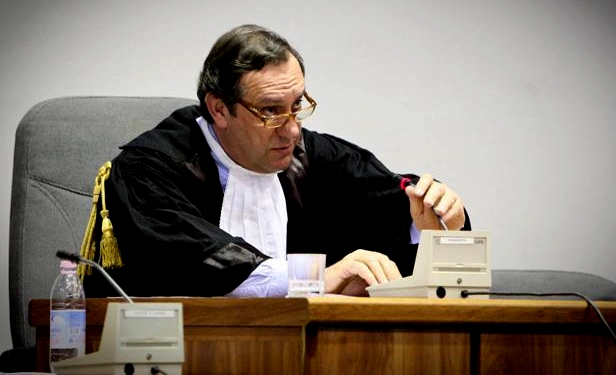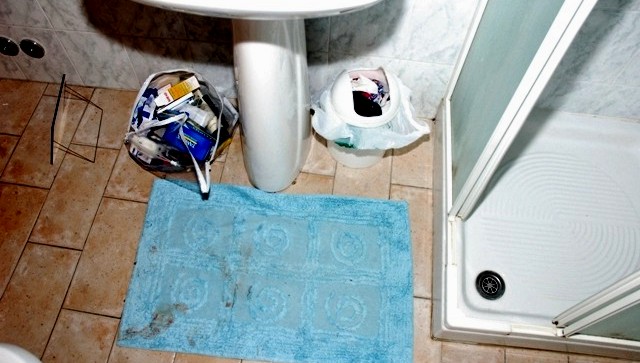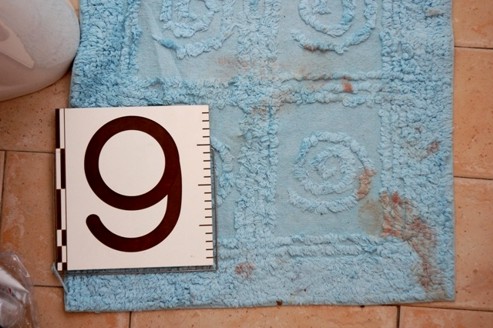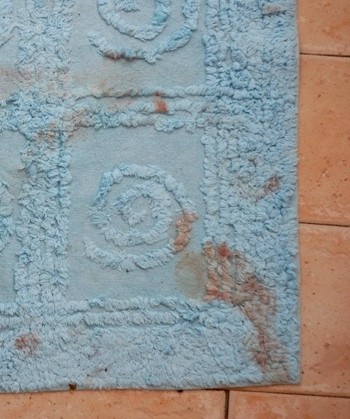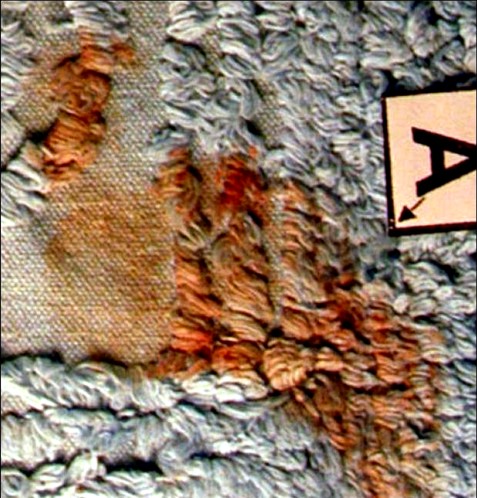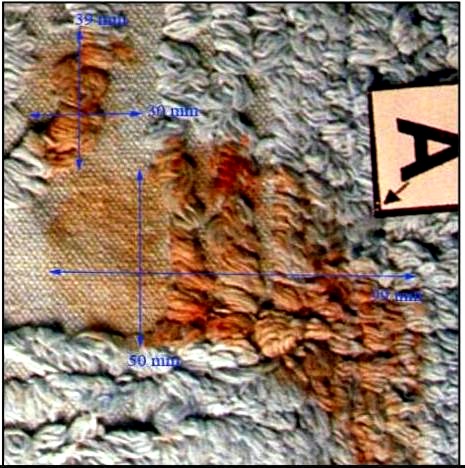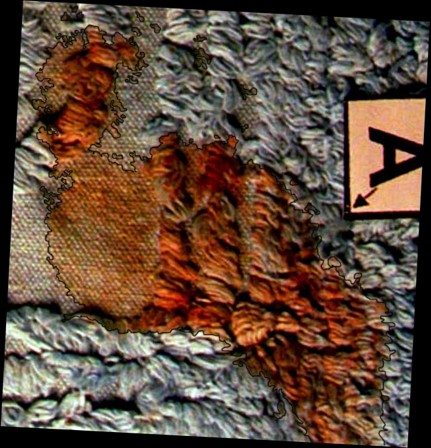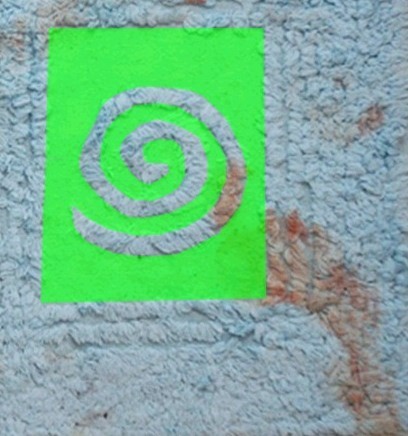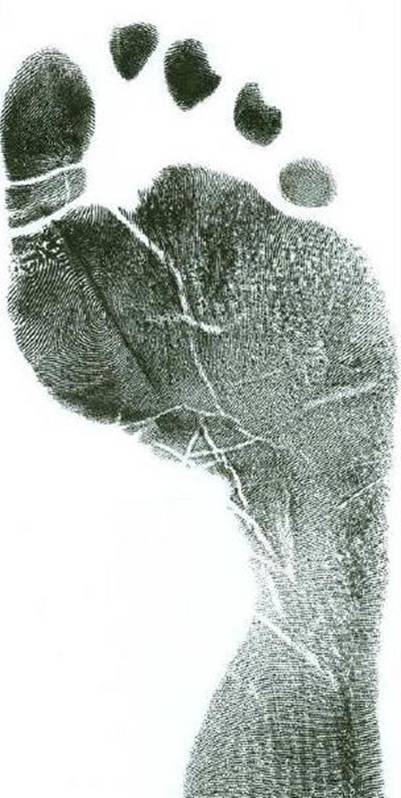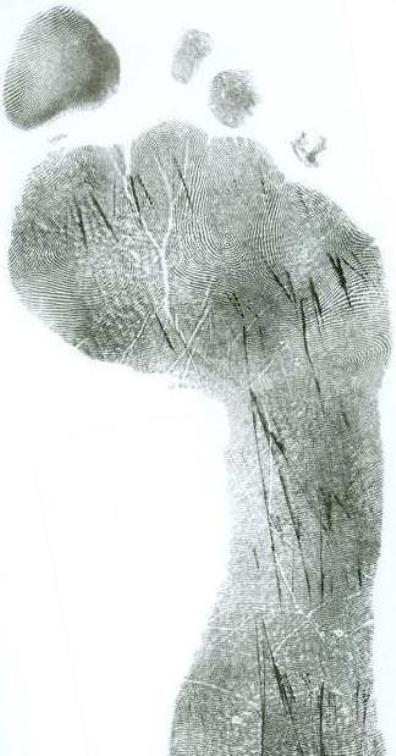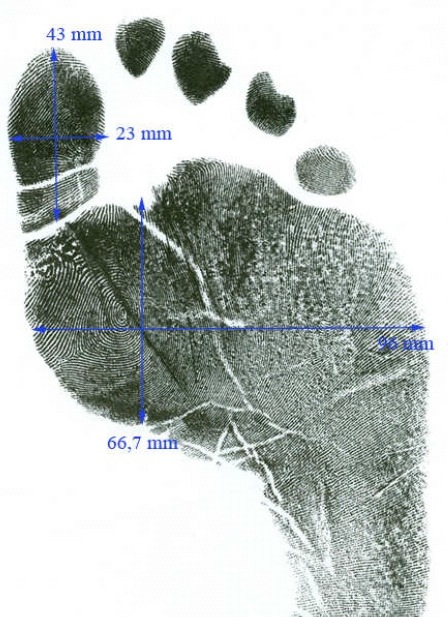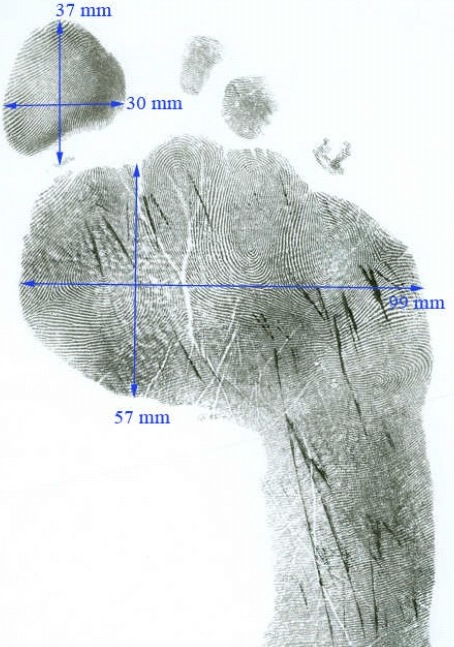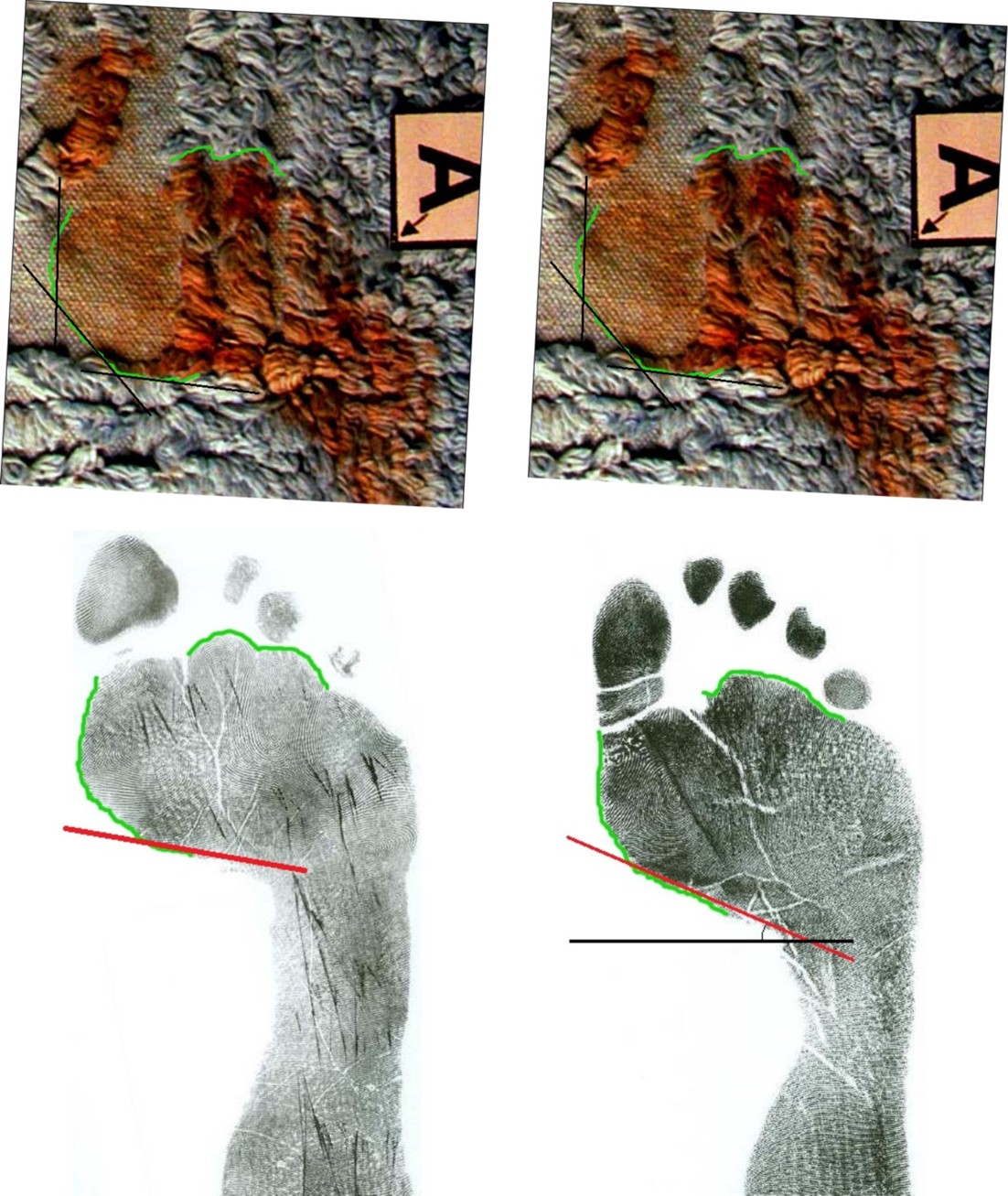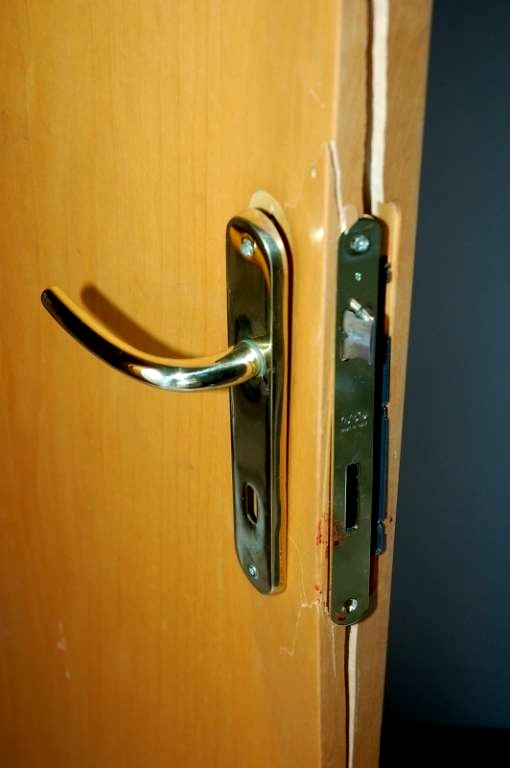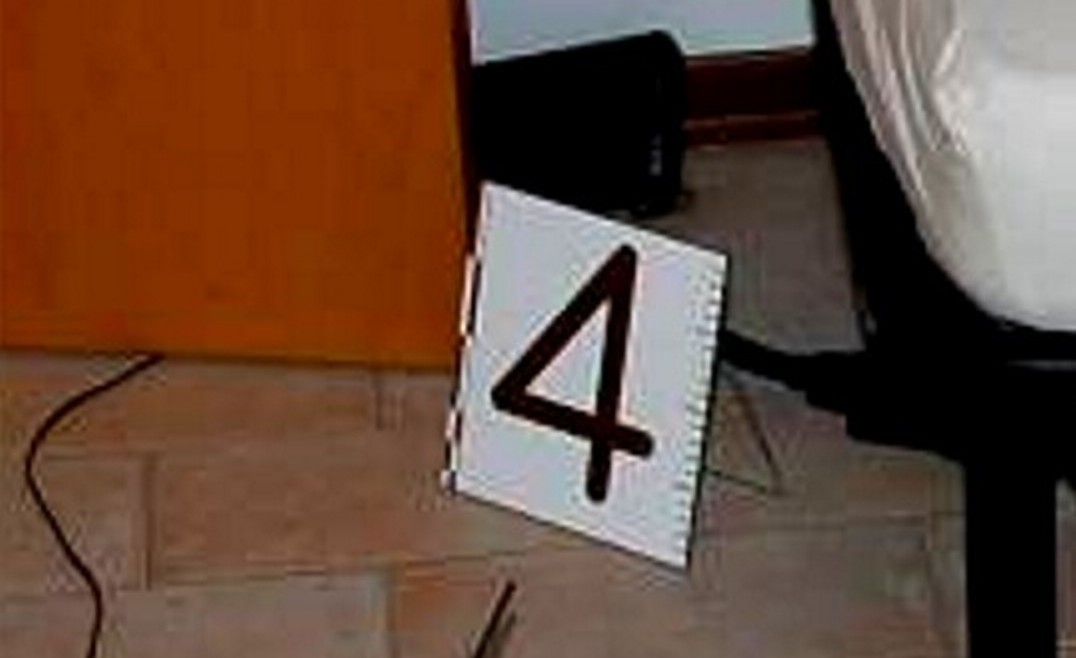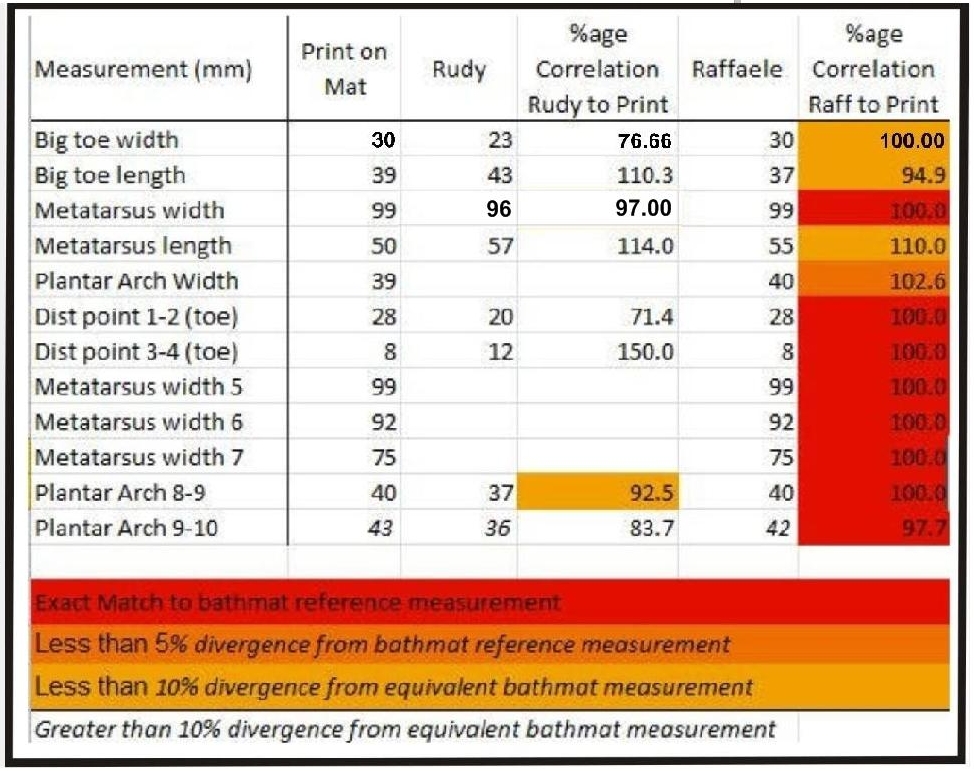
Category: Other physical
Wednesday, June 17, 2015
Major Additions To Meredith Kercher Case Wiki To Provide Complete Impartial Overview in English
Posted by azoza
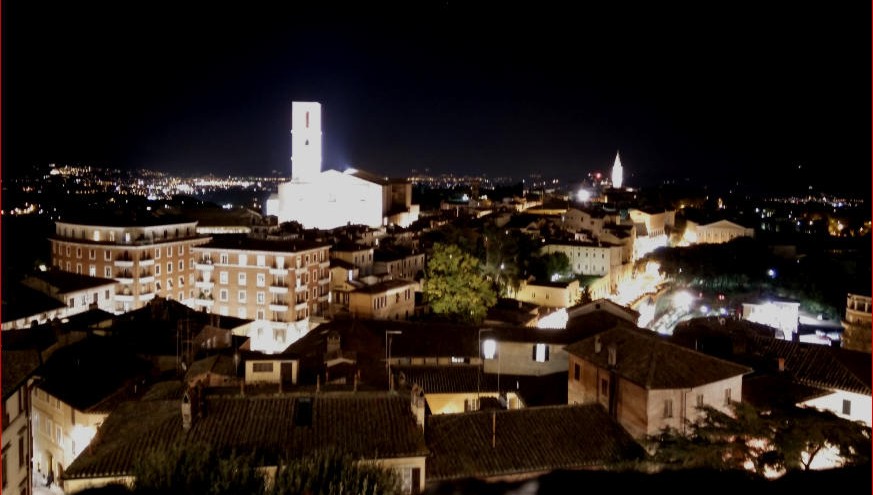
Image is of the very beautiful Perugia at night
Origin and mission
The impartial Murder of Meredith Kercher Wiki began in 2013.
The seed was people discussing how to overcome the flawed Wikipedia article of the case. That article relied on sources like Candace Dempsey, Nina Burleigh and American media. In other words, biased or incomplete sources.
In May 2013, Edward McCall set up the website, with the help of volunteer editors from the Perugia Murder File community. Its mission statement was:
Were Amanda Knox, Raffaele Sollecito, and Rudy Guede responsible for the death of Meredith Kercher? This wiki style site was created by a group of volunteer editors to inform the public about the case, by providing translations of original documents and evidence presented at trial.
This continues to be the aim of the Wiki: to make available documents and translate them properly. Our interest is not selectively posting documents, like the Knox campaign has done. We want to make all the facts available, without bias or selecting. We believe all the facts support the notion that all three defendants are responsible for Meredith Kercher’s murder.
Purpose of this post
The purpose of the article here is to let people know of recent changes to the website.
The Wiki is revised when new documents and translations continue to be received. Existing webpages are tweaked when time allows. Webpages are sometimes changed so information can be better presented. Or the website structure is changed when a significant page is introduced.
For example, a new page listing a lot of evidence was added in November 2014. This page can be directly accessed from the main page. That evidence list page has links to other sections of the website, like “˜wikified’ testimony, for easier reference. More links will be added and more evidence noted as more documents become available.
Major redesigns
The website had two major redesigns earlier this year. The main page was redesigned to provide clearer “˜at a glance’ updates. We did this primarily to keep everyone up-to-date with the March 2015 Cassazione decision. The boxes on the main page also note updates to other parts of the website. Also, we added buttons so any webpage on the site can be shared on various social media.
The other major redesign has been the addition of the “˜file library’.
Completing the picture
For those long familiar with the case, source material had been seriously lacking. There have been large gaps. The Knox campaign has posted some documents, but their “˜collection’ has always been incomplete. As examples:
1) The crime scene photos start at “˜dsc016’. What about photos 1 through 15?
2) No photos of Sollecito’s place, Guede’s place, via Sperandio or elsewhere
3) They posted many Massei transcripts, but not all. They never posted the 2nd day of Knox’s testimony, or the days when the Kercher family and consultants testified.
4) Some Massei transcripts they posted had pages missing.
5) They have posted many defense consultant reports, but few prosecution consultant reports.
6) They only posted a few Hellmann transcripts, but not all.
7) They only posted one Micheli transcript, but not the others.
8) Hardly any depositions.
9) A lot of police reports are still missing.
In the past six months, we have been trying to correct this. We have set up a file library, which will be the repository of as many case-related files as can be gotten. Files will ultimately include documents, photos, videos and audio- whatever is part of the public record of this tragic case. The files are made available as links for downloading. Eventually many will also be “˜wikified’ so anyone can do a word search through the documents. And when time allows, key documents will be translated.
There are thousands of files related to this case - too many to put on one page. A single file page would take forever to scroll and would be terribly confusing. So the library is structured into subsections. The basic idea is “˜nested boxes’. Once you select a section, you “˜drill down’ through pages to get to document links. Then you click “˜back up’ to the higher levels so you can move to other sections.
Some pages have a mixture of links to documents and links to subpages. These will eventually be simplified for clarity.
Not all file library pages have been created. More pages will be required as more files come in. Once the document files (PDFs) portion is nearly complete, pages will be reviewed and the library layout will be tweaked. At that point, when we’re comfortable with all the pages and their names, links will be added to allow browsing across sections or in sequential order. This hasn’t been done yet to avoid redoing a lot of work later.
A directory tree is a strong possibility too.
The seven sections
The library has over 900 PDFs and photos scattered across 7 major sections.
The 1st section
This section Context and people is empty for now. It will have photos of Perugia, the cottage, nearby locales and pictures of the people involved in the case. We are sifting through photos and erasing duplicates. Once that’s done, this section will quickly fill out.
The 2nd section
This section 2007 Investigations has files related to police investigations in 2007, the arrest and crime scene photos and videos. As mentioned, not all crime scene photos and videos have been made public. We hope to gather as complete a collection as possible. Of course, anything showing Meredith Kercher’s body will be censored, in line with the wishes of the Kercher family, and to maintain dignity. In the past 1.5 months, we’ve gotten over 80 depositions of witnesses and other documents related to early investigations. Things like preliminary police reports and police correspondence. Here you can also find phone and prison taps.
The 3rd section
This section Arrest trials has filed related to the cautionary arrest trials. This includes the Matteini court, the Ricciarelli court and the 2008 Cassazione court, presided by judges Gemelli & Gironi. Files include court hearing transcripts, motivation reports and other files pertinent to these hearings. This is missing quite a bit still, but we hope to correct that.
The 4th section
This section 2008 Investigations has files related to police investigations in 2008. While the murder was discovered on Nov 2, 2007, and arrests were made that month, the actual police investigation continued until the following year, finishing in June 2008. Files here include additional phone and prison taps, police reports from Rome and Perugia, additional depositions and other related documents.
The 5th section
This section Statements and writings contains writings and depositions of the three defendants. GKS = “Guede Knox Sollecito”.
The 6th section
This section Trials and Appeals and Reports is the largest section. We may revise or split this section further. Currently it contains all documents related to the main trials. All three defendants took part in the first main trial, the 2008 Micheli court. Micheli indicted Guede and found enough evidence against Knox and Sollecito. After the Micheli court, Guede’s trial path separated from the other two because he chose a fast-track option. So there are 3 subsections: Micheli, Guede trials and Knox + Sollecito trials. The Knox + Sollecito trials page has further subpages for the Massei court, the Hellmann appeals court, the Nencini appeals court. In this section, one can find court transcripts and reports, correspondence or depositions introduced during court proceedings. So a lot of files.
The 7th section
This section is extra material.This will contain documents, photos and videos indirectly related to the case. Things like interviews, documents on forensics, lab manuals, crime scene analyses, documentaries, related trials like the police calumnia trials, etc.
A few quick notes:
1. There are many versions of the Massei motivations report on the Internet. Most are missing two pages. Another version comes in four parts. We edited ours so this is a complete version with the “˜famous’ missing pages.
2. Similarly with the Borsini-Belardi motivation report. Many versions out there, most of them improperly OCR’ed, with sections missing. Our version is a scan version, not the OCRed one.
3. As noted before, recent additions include a lot of depositions of witnesses taken in the first week of police investigation. You can find these in the “2007 police work” page.
4. Police summaries of the crime scene surveys, and fingerprint reports, are at the bottom of that same page.
5. There’s a PDF containing a “˜5 volume’ police photo report. This PDF has photos of Via Sperandio currently not in the crime scene photos. But certainly those photos are part of the same Nov. 2007 crime scene photo survey. Anyway, you can find it in the Crime Scene page at the bottom. It’s called Photo-photographic-file-censored. We edited out pictures of the body, to preserve dignity of the victim.
6. Towards the bottom of the “2008 investigations” page, we recently added two police charts, and the first “shoeprint report” by Rinaldi & Boemia, which has more data on shoeprints. Their second report concentrated on the footprints.
7. We have the Cassazione March 2015 dispositivo. We will be posting that along with other documents shortly.
In conclusion
The file library is an ongoing thing. We hope to make real progress here, so everyone can look at all the facts of the case, not just a few picks. A bright light is needed on as much material as is possible to offer, in honor of Meredith Kercher, the victim.
When we post a new file batch, we add an update note on the Wiki home page.
The Meredith Kercher Wiki is committed to being the essential record of all publicly available documents and testimonies about the case, to benefit the general public and the media. Please circulate this widely, and check in regularly. There are more changes to come.
ADDED 12 JULY
On 2007 Investigations: Police work page
2007-11-03-Log-cellphone-KercherM-English.pdf
2007-11-03-Log-cellphone-Sollecito.pdf
2007-11-07-Log-landphone-Sollecito.pdf
2007-11-27-Police-deposition-Capezzali.pdf
On 2007 Investigations: Arrests page
2007-11-07-Prosecutor-notice-Request-to-validate-Arrest-Knox-Lumumba-Sollecito.pdf
On Arrest trials page
2008-01-21-Testimony-Bernaschi-Sollecito.pdf
2008-05-15-Motivazioni-Matteini-reconfirming-cautionary-arrest-Knox.pdf
On Arrest trials: KSL: Matteini trial page
2007-11-08-Testimony-Matteini-Knox.pdf
On Arrest trials: KS: Ricciarelli trial page
2007-11-30-Motivazioni-Ricciarelli-Arresto-Appello-Knox-Sollecito.pdf (forever missing Ricciarelli report)
On 2008 Investigations page
2008-11-08-Deposition-Monacchia.pdf
On Trials: Micheli court page
2008-09-16-Testimony-Summary-and-Rulings-Micheli.pdf (first Micheli hearing)
2008-10-27-Report-Fioravanti-Vodaphone.pdf
On Trials: KS: Massei and Cristiani trial page
2009-11-20-Closing-arguments-Mignini.pdf (forever missing)
2009-11-21-Closing-arguments-Comodi-Knox.pdf (forever missing- Comodi describes 3D reconstruction)
On Trials: KS: Hellmann and Zanetti trial page
2010-12-11-Testimony-Lawyers-Knox-Parisi-Maori-Ghirga-Vedova.pdf (missing Hellmann hearings)
2010-12-18-Testimony-Costagliola-Comodi-Perna.pdf
2011-01-22-Testimony-Lawyers.pdf
2011-03-12-Testimony-Mandarino-Pucciarini-Ciasullo-Bevilacqua-IniG-IniR.pdf
2011-03-26-Testimony-Brughini-Curatolo-Lucarelli.pdf
2011-05-21-Testimony-Napoleoni-Conti-Vecchiotti-Knox.pdf
2010-12-11-Court-doc-Zanetti-case-review.pdf
On Trials: KS: Nencini and Cicerchia trial page
2014-01-20-Testimony-Maori-Crini-Pacelli-Fabiani-Perna-Maresca-Donati-Colotti.pdf (missing Nencini hearing)
On Trials: Knox and Sollecito trials page
2015-03-30-Sentenza-Cassazione-Dispositivo-Knox-Sollecito.pdf (sentence, not motivations report)
Saturday, April 11, 2015
Those Pesky Certainties Cassation’s Fifth Chambers May Or May Not Convincingly Contend With #1
Posted by Cardiol MD

The Italian Supreme Court is in the background
1. How Overload Can Overwhelm The Checks And Balances
The Italian Supreme Court (SCC) has 396 Judges in Rome and elsewhere.
Because of the enormous pro-defendant tilt in the system, the SCC hears about 80,000 appeals a year - more than all other Supreme Courts in the rest of Europe combined.
The SCC operates in panels, typically of 5 justices; that scales to about 4 appeals/panel/workweek, or about 1 appeal/panel/workday. A huge workload impinging on carefulness and promoting distraction and exhaustion.
Even with a law-clerk infrastructure, and the most ingenious exploitation of human concentrated-attention-span, highly questionable outcomes such as that for Meredith’s case would seem inevitable.
The four SCC judges panels (2008, 2010, 2013, 2015) which have ruled on various issues arising as Meredith’s murder case inched its way through the Italian legal system have been composed of different judge-combinations, with different skills, different knowledge, different education, and different experiences.
In many cases high-tech issues are an integral part of the evidence before the courts. This requires the enlistment of expert opinions because the judges may not be versant in the relevant high-tech issues. All sides, the defence, the prosecution, other interested parties, and even the judges, can cherry-pick experts for hire, who often use brazen sophistry to persuade the judges in the experts’ favour.
These facts may help to explain if not justify the unexpected conclusion of this current SCC judges panel which is now drafting the Motivazione.
2. Circumstantial Evidence And The Italian Requirement For Certainty
Near the start of the 2015 SCC hearings Judge Bruno, one of the 5 members of the Marasca SCC-Panel, was quoted as having said that the trials had “not many certainties beyond the girl’s death and one definitely convicted.”
As we await this particular Motivazione intended to explain its decision, we will review the Massei Motivazione, the Nencini Motivazione, and the several past SCC rulings to establish what do constitute the certainties - of which in fact as Italian law defines them there is actually a large number.
In order to be classified as Circumstantial Evidence in Italian Law an evidentiary circumstance or fact must be true to the level of being a certainty. Note that this rule does not supersede BARD, it applies only to the the acceptance of individual items of evidence as circumstantial, so it can mislead and confuse authors and readers.
As will be noted below, under this Italian requirement the unverifiable RS/AK broken water-pipe story can not be classified as pro-defense Circumstantial Evidence. Therefore it cannot legally be argued as corroboration of the excuses of Knox & Sollecito, including their mop claims.
Sollecito’s father, Dr. Francesco Sollecito, did say that RS had mentioned the alleged-leak of Nov. 1st, 2007, in the father’s 221 seconds, 20:42:56 call of Nov.1st, 2007. Hellmann/Zanetti bought into this story, discussing it in their Motivazione.
AK is quoted by Nencini as referring to the alleged-leak in her testimony, but neither Galati nor the 2013 Hellmann/Zanetti-annulling SCC panel mentioned the alleged-leak. All seemed aware that there was no certainty.
3. An Explanation Of Why This Will Matter So Much In Future
In 2013 the SCC itself annulled most of the Hellmann-Zanetti verdict in part because there was an obvious parceling-out of the pieces of circumstantial evidence and a lack of assessment of each piece of circumstantial evidence. Hellmann-Zanetti had failed to check whether the possible flaws and lacks in the logical value of each single piece of evidence could be resolved by cross-checking them and taking in account the whole.
Have the SCC judges themselves now made this same mistake? It is especially at this level that informed legal analysis in Italy of the pending SCC Motivazione will concentrate, future books on the case will concentrate, and the final degree of legitimacy will be established.
Given the peculiarity that the case was not referred back down to Florence for adjustment, worries at this level especially could be driving the very obvious nervousness of all of the defense counsels, shushing and restraining their clients in the presumed hope that the SCC judges really can square the circle and achieve legitimacy.
4. Certainties And Certainly-Nots In The Circumstantial Evidence
1. Fracture Of Hyoid Bone?
The SCC-Panel for Guede’s Sentencing (English Translation) wrote on Pages 4-5:
c) The body presented a very large number of bruising and superficial wounds ““ around 43 counting those caused by her falling ““ some due to a pointed and cutting weapon, others to strong pressure: on the limbs, the mouth, the nose, the left cheek, and some superficial grazing on the lower neck, a wound on the left hand, several superficial knife wounds or defence wounds on the palm and thumb of the right hand, bruises on the right elbow and forearm, ecchymosis on the lower limbs, on the front and inside of the left thigh, on the middle part of the right leg, and a deep knife wound which completely cut through the upper right thyroid artery fracturing the hyoid bone, a wound which caused a great deal of bleeding from the vessels of both lungs.
This caused a haemorrhagic shock and asphyxiation by the presence of blood in the respiratory passages, an exitus [decease] placed at around 23:00 of Nov. 1 by the forensic pathologist.
The emphases are mine. The knife cut through the hyoid bone rather than fractured it (in the English version it should say that it severed the hyoid bone; this is a translation issue). A Certainly-Not then.
The wound certainly did not cause any bleeding at all from the vessels of either lung; this is not a translation issue. This is a factual error in the original Italian Sentencing Report. A Certainly-Not then.
(This shows how the SCC-Panel Reports are not infallible. Unfortunately the Marasca Panel will have to dredge-up some past, fallible SCC-Panel Reports in order to explain its own reasoning.)
2. Two Knives?
Massei Translation p377: “There must necessarily have been [405] two knives at the scene of the crime.”
Certainly! There were 2 major, penetrating knife-wounds into Meredith’s neck; one entering on the left-side, and one entering on the right-side, which was made by a pocket-knife of the size Sollecito customarily carried. The latter wound could not have been made by whatever knife entered on the left-side. Therefore 2 knives were Certainly used.
3. Single Blow?
Massei Translation p 371 “”¦a single blow was apparently halted by the jawbone”¦”
Certainly Not.
The statement that a blow could be “apparently halted” by Meredith’s jawbone is at best a figure of speech, and the quotes of Prof Cingolani on page 152 of the Massei Translation clearly indicate that any cause and effect inference from the phrase “apparently halted”, “did not”¦. have elements of certainty to establish” it was “stopped by the jawbone.” Prof Cingolani “did not, however, have elements of certainty to establish that the blade which had caused the wound 4 centimetres deep had stopped at the said depth because [it was] stopped by the jawbone.”
Maybe there is a Judicial, translational, or typographical glitch and “by” the jawbone should have been “near” the jawbone. Skin is soft and bone is harder but there is no way that the knife striking the jawbone or hyoid bone would halt the knife in this case, they would just roll with the blow, depending on the angle of attack.
Furthermore, contact between the knife and jawbone or hyoid bone would not mark the knife because living-bone is softer than the knife. When your pet gnaws on a non-living cow-bone, neither the bone nor your pet’s teeth can bend; both your pet’s teeth and the bone can be broken, and the bone gets scratches on it because it is still softer than the teeth, but your pet’s teeth do not get scratches on them, because they are harder even than the non-living bone.
If someone is stabbed in the back with a kitchen carving knife, penetrating ribs on its way to the heart, the knife may have no scratches at all, nor show any signs of damage caused by that action. Any implication in the statement quoted above that stabbing Meredith’s neck with enough force to penetrate the layers of her neck and then strike bone would have the effect of signs of damage to the knife-blade, is a mistaken implication.
It is an old rule of materials-physics that a softer substance cannot mark a harder substance. [To some people this may be counter to their intuition, so I have passed it by an eminent MIT physicist, and he agrees with me that the knife blade would certainly not show signs of damage caused by the stabbing in this case.]
4. SMS Message?
It is Certain that at 20:18:12 on Nov.1st, 2007 Amanda Knox’s mobile-phone received the SMS sent to her by Patrick Lumumba, which let her off from having to go to work at the “šLe Chic? pub on the evening of 1 November.
Remember that mobile-phones are equivalent to convicts’ ankle-monitor bracelets, their use creates with Certainty a record of the Times of cell-phone activities, the Location of the corresponding transmitter-cell, and hence the general location of the mobile-phone, especially Ruling-Out particular Locations e.g. Proving whether the carrier of the phone was in or out of the range of their home transmitter-cell. Call Verbal-Content is not publicly available.
Here the mobile-phone Record proves that Knox’s mobile-phone was Certainly-Not in Sollecito’s lodging-house at 20:18:12 on Nov.1st, 2007:
At the time of reception, Knox’s phone connected to the cell on Via dell’Aquila 5-Torre dell’Acquedotto sector 3, whose signal does not reach Raffaele Sollecito’s house. Amanda Knox’s mobile phone, and therefore Knox herself, was therefore far [i.e. absent] from Corso Garibaldi 30 when the SMS reached her, as she was walking in an area which was shown to be served by the Via dell’Aquila 5-Torre dell’Acquedotto sector 3 cell.
This point of her route could correspond to Via U. Rocchi, to Piazza Cavallotti, to Piazza IV Novembre, bearing in mind that Lumumba’s pub is located in Via Alessi, and that Amanda Knox would have had to travel along the above-mentioned roads and the piazza in order to reach the pub.
Knox was therefore Certainly Not at Sollecito’s Corso Garibaldi Lodging at that time, contrary to the allegation that she was, and Knox Certainly-Could have been at her Cottage.
5. SMS Reply?
At 20.35.48 on Nov.1st, 2007, Amanda Knox Certainly sent an SMS in reply to Patrick, at No. 338-7195723; the message was sent when her on Nov.1st, 2007 mobile phone was in Corso Garibaldi 30 or in the immediate neighbourhood. The cell used, in fact, was that of Via Berardi sector 7 - no other [use] was shown for the day of 1.11.07, noting that Amanda declared during hearings that she had switched her mobile phone off once she had returned 323 to Raffaele’s house, claiming she was more than happy she did not have to go to work and could spend the evening with her boyfriend.
(Knox may also have been LESS than happy that Lumumba preferred Meredith instead of Knox as an employee. This was perhaps humiliating enough to Knox for Knox to decide that the time to cut Meredith down-to-size was now.)
6. Bomb Threat?
Massei Translation page 25: On “the evening of November 1, 2007 at around 10:00 pm, someone called and warned Elisabetta Lana not to use the toilet of her dwelling because it contained a bomb which could explode. Mrs. Lana immediately notified the police of this phone call; and they came to the house but did not find anything….”
This call was Certainly received, the Police Certainly came to Mrs. Lana’s home, presumably not long after 10: pm on the evening of November 1, 2007 (Time & Duration of Police presence apparently not publicly-available).
The Courts must know those times accurately and precisely; reasonably assuming them to be after Meredith’s murder, and near the time of the Phone-Dump (Otherwise, the necessary combination of coincidences is too implausible).
It is most likely that the visible, and possibly audible, presence of Police triggered the panicked disposal of the Cell-Phones down the steep slope that falls sharply into the valley below.
There is no need to invoke any awareness by the phone-dumper[s] of the reason(the hoax-call) that the Police were near Mrs. Lana’s residence.
So if the killers saw flashing police-lights, or any other sign of police near Mrs. Lana’s place, that sign could be enough to explain panic phone-dumping - then and there (not considering whether the phones were switched-on or switched-off).
According to John Follain the slope is heavily overgrown with trees and bushes, an ideal place to dispose of evidence. If the phones had fallen just a few yards further, they would certainly have gone over the edge of the cliff, down into a 50m gully, straight into a thick scrub of nettles, and probably been lost forever”¦.
7. Phone Dialings?
There were four dialings on Meredith’s mobile phones after her arrival home on the evening of 1 November ‘07:
i. 20:56 hours on 1 November 07, attempted call to Meredith’s mother’s home in England.
ii. 21:58 hours on 1 November 07, attempted call to mobile phone’s answering service, voicemail “˜901’.
iii. 22:00 hours on 1 November 07, dial to Meredith’s London bank “˜ABBEY’.
iv. 22:13:29 hours (9 seconds) on 1 November 07, attempted internet connection. Connection consistent with being attempted from cottage, but inconsistent with being attempted from Mrs.Lana’s.
These dialings are Certain with regard to Existence, Timings, and Location.
Massei Translation, page 331, attributes the above 4 dialings to Meredith absent-mindedly playing with the mobile phone in her hand, and her phone may well have still been in her hand when her attackers surprised her.
8. Phone Location?
Was Meredith’s Phone still in the cottage at Via della Pergola at 22:13:29 hours on 1 November 07? Yes. Certainly.
9. A Tow Truck?
At about 22:30 hours Car broken-down nearby. Tow-Truck called-for.
At about 23:00 hours Tow-Truck arrives to load car.
At about 23:13 hours Tow-Truck leaves with loaded car.
These events Certainly occurred, but those times are approximate.
10. Francesco Called?
@23:41:11 RS’s father attempts phone-call but makes no oral contact. Father leaves message which is not received until 06:02:59 on 2.11.07.
This 23:41:11 call was attempted during the very time-frame of the attack on Meredith, her murder, and the flight of her killers with her mobile telephones. Meredith’s Phone[s] were removed from her cottage by about Midnight, less than 20 minutes after this attempted call.
These phone calls are Certain wrt Existence, Timings, and Locations.
11. Phone Location?
For 2.11.07 the first record is that of MKP - [0]0:10: 31, (i.e. Very early in the a.m. 10 minutes and 31 seconds after midnight) “when it has been established as an incontrovertible fact that Meredith’s English mobile phone was no longer in Via della Pergola, the mobile phone having received the contact under the coverage from Wind signal [cell] ..25622, which is incompatible with the cottage.”
Was Meredith’s Phone still in the cottage at Via della Pergola at 00:10: 31, 2.11.07? No!
Therefore Meredith’s English mobile phone had been removed from her cottage between 10.13.39 p.m. on 1.11.07 (more likely about 11.13 p.m. when tow-truck departed) and 0:10:31 on 2:11:07; about 10 ½ minutes after midnight ““ say Meredith’s Phone[s] Removed By About Midnight, allowing for the time-elapse before being dumped near Mrs. Lana’s place. (Hellmann falsified this time-span on page 14 of his report, stating it to be more than 10 hours after midnight rather than about 10 ½ minutes after midnight.)
12. Phones Stolen?
At some time before Meredith’s attackers fled, they had seized her mobile telephones, probably near the beginning of the attack, having started their attack with a pre-emptive strike to intimidate Meredith, remove all hope, surround her, display knives, seal all possible escape-routes, and remove any possibility of phone-calling for help.
Immediately after Meredith’s scream her attackers had silenced her with the fatal stabbing, and then fled immediately.
They fled with her already-seized but still switched-on mobile telephones, probably without locking anything, including Meredith’s door.
Their over-riding and 1st imperative was not-to-be-caught-at-the-crime-scene.
See item 6. above.
13. Crimescene Meddling?
Having accomplished the Phone-Dump, Meredith’s killers next re-model the crime-scene, minimising the evidences of their identities, cleaning-up the evidences that it was “˜an inside job’, and simulating the appearances that it was “˜an outside job’.
One should bear in mind that these killers should have still been overwhelmed by their having actually committed a crime beyond their wildest imaginings.
Their panic impaired their thinking, and their ignorance, immaturity, inexperience, lack of technical resources and their arrogance precluded their selecting deceptions more effective against knowledgeable, experienced professional crime-investigators with a large fund of resources. They probably think that throwing the stone from inside Filomena’s room was a brilliant deception.
They wish it had never happened.
They wish they could make it unhappen (Hellmann/Zanetti got close to fulfilling this wish, but got themselves unhappened by Cassation)
They wish they could prevent the discovery of Meredith’s murder.
They cannot prevent the discovery of Meredith’s murder.
They may be able to postpone its discovery, but not longer than the inevitable return of the cottage-mates, later that day.
They believe that the person who “˜discovers’ a murder may become 1st-suspect.
They may be able to manouevre others-than-themselves into being the ones that make the discovery ““ quite a wily aim.
It is beyond reasonable doubt that:
Meredith’s killers seized her mobile telephones, and that
Her killers did not switch-off these mobile telephones, and that.
Her killers threw the telephones into an apparent ravine, landing in Mrs.Lana’s garden, and that
This phone-dump was accomplished before 00:10: 31, 2.11.07, and that
Amanda Knox caused:
- i. the English phone to ring at 12:07:12 (16 seconds) and be discovered by Mrs.Lana’s daughter only because it rang , and
ii. the other phone, registered to Filomena Romanelli, to ring, very briefly, at 12:11:02 (3 seconds) and,
iii. the English phone to ring again, also very briefly, at 12:11:54 (4 seconds), after being brought into Mrs.Lana’s house. 6. Sollecito had more than 5 days, from about 11.30 pm on November 1st, 2007 until November 6, 2007, to remove from the killing-knife the traces of Meredith’s DNA.
In the opinion of the Court of Assizes (Massei Translation p.325), Amanda Knox’s call to Meredith’s phone was
...the first indispensible step before putting the [348] planned staging into action. The lack of a reply, since the poor girl was obviously already dead, gave a reason for reassurance about the fact that the young woman’s phone had not somehow been retrieved, [and] was therefore safe in the spot where it had been thrown, which, according to the expectations [in the minds] of the murderers was a precipice or some other inaccessible spot, rather than in the garden of a villa located barely outside the city, where the vegetation concealed it from view.
Knox may well have expected that she was safe from phone-discovery, but these calls turned out to be the very instrument of a phone-discovery.
Had Knox not made these obfuscatory stabs, in the time-frame she made them Meredith’s phone would not have rung when it did ring and would therefore not have been discovered by Mrs. Lana’s daughter when she did discover it.
14. Phone Switched On?
For the day of 2.11.07, when Meredith was already dead, the traffic registered for the Vodafone number was shown to be the following:
00:10:31; duration and caller unspecified, but Wind signal [cell] incompatible with cottage, but compatible with Mrs. Lana’s place.
Therefore, Meredith’s mobile cell-phone had already been taken away from the cottage by her killers. It is not possible to determine from this phone-record whether the phone was switched on or off, but this phone was discovered at Mrs. Lana’s place because it was ringing, and therefore was “on”.
12:11:02 (duration of 3 seconds): Knox’s phone call reached the phone and was diverted to the answering service. The Vodafone cell used by Meredith’s service provider was situated in Strada Vicinale S. Maria della Collina sector 1.
12:11:54 (4 seconds): another call is made by Knox’s phone towards Meredith’s English mobile phone number (the cell used is the one in Via dell’Aquila 5-Torre dell’Acquedotto sector 3, thus compatible with Sollecito’s house)
Three more phone-calls Certain wrt Existence, Timings, and Locations.
15. Francesco SMS Received?
At 06:02:59 Raffaele Sollecito received the SMS from his father allegedly wishing Raffaelle a good night; from the evidence of the mobile phone record printouts of Dr. Francesco Sollecito, it was shown that the sending of the message occurred at, as has been said, 23:41:11 of 1.11.07. This was the last SMS sent from that mobile phone during the whole day of 1.11.07
3+ Hours after receiving his father’s message from 23:41:11 of 1.11.07:
At 09:24 Raffaele Sollecito received a phone call from his father lasting 248 seconds]
At this time RS’s consiousness would be dominated by his guilty knowledge, and probably far-advanced in the accomplishment of the 3rd imperative.
Did RS and father spend 4+ minutes discussing the weather?
This is the first father/son opportunity to formulate the two-pronged water-leak story.
Although AK had already been to the hardware store 2 hours before, they may well not have known the potential DNA problems with the knife, the need to scrub it vigorously, to clean-out, and repair the drain-pipes under the sink, and the need to return the knife to RS’s kitchen drawer.
As it turned-out, Sollecito had more than 5 days, from about 11.30 pm on November 1st, 2007 until November 6, 2007, to remove from the killing-knife the traces of Meredith’s DNA.
They probably did not know that incriminating stains could be invisible, but can be revealed by Luminol.
16. Francesco Calls Received?
At 09:29 another call was received lasting 38 seconds
At 09:30 (duration unspecified?) the father called Raffaele; the call connected to the Vial Belardi sector 7 cell.(the best server cell for Corso Garibaldi 30).]
These two calls, Certain wrt Existence, Timings, and Locations, were probably spent dotting “˜i’s, crossing “˜t’s, and exchanging options, such as enlisting sister Vanessa’s skills and contacts.
17. More Calls Later?
Another 2+ Hours later:
At 12:07:12 (duration of 16 seconds) Amanda calls the English phone number 00447841131571belonging to Meredith Kercher. The mobile phone connects to the cell at [346] Via dell’Aquila 5-Torre dell’Acquedotto sector 9 (the signal from this cell is picked up at Sollecito’s house)
At 12.08.44 (lasted 68 seconds) Amanda calls Romanelli Filomena on number 347-1073006; the mobile phone connects to the Via dell’Aquila 5-Torre dell’Acquedotto sector 3 cell (which covers Sollecito’s house)
Discovery will be inevitable when Filomena eventually arrives-back at the cottage.
AK/RS have accepted that they have to “˜stand-pat’ with their efforts so-far to accomplish not-to-be-the-“discoverers”-of-Meredith’s-body.
Amanda did not say a word in this phone-call to Filomena about Amanda’s phone call to Meredith, thereby withholding information that should have led Amanda to initiate discovery of Meredith’s body, and help Amanda to manouevre someone other than Amanda into being the one who “˜discovers’ Meredith’s body.
At 12:11:02 (3 seconds) the Vodafone number 348-4673711 belonging to Meredith (this is the one [i.e. SIM card] registered to Romanelli Filomena) is called and its answering service is activated (cell used: Via dell’Aquila 5-Torre dell’Acquedotto sector3)
18. Yet More Calls?
For the day of 2.11.07, when Meredith was already dead, the traffic registered for the Vodafone number was shown to be the following 5 calls, Certain wrt Existence, Timings, and Locations:
- i. 12:11:02 (duration of 3 seconds): Amanda’s phone call reached the phone and was diverted to the answering service. The Vodafone cell used by Meredith’s service provider was situated in Strada Vicinale S. Maria della Collina sector 1.
ii. 12:11:54 (4 seconds): another call is made towards Meredith’s English mobile phone number (the cell used is the one in Via dell’Aquila 5-Torre dell’Acquedotto sector 3, thus compatible with Sollecito’s house)
iii. 12:12:35 (lasting 36 seconds) Romanelli Filomena calls Amanda Knox (No. 348-4673590); Amanda receives the call connecting to the cell on Via dell’Aquila 5-Torre dell’Acquedotto sector 3 (still at Raffaele’s house)
iv. 12:20:44 (lasting 65 seconds) Romanelli F. calls Amanda, who receives the call connecting to the cell in Via dell’Aquila 5-Torre dell’Acquedotto sector 9 (good for Corso Garibaldi 30)
v. 12:34:56 (48 seconds): Filomena calls Amanda who receives it from the cottage on Via della Pergola 7 (the cell used is that on Piazza Lupattelli sector 7. As mentioned, Raffaele also used the same cell when he called the service centre at 12:35 hours to recharge [the credit of] his mobile phone)
19. RS Phone Location?
At 12:35: Raffaele’s mobile phone contacted a service centre for a phone [credit] recharge (the cell used was that of Piazza Lupattelli sector 7, which gives coverage to the little house on Via della Pergola 7. The signal in question does not reach Corso Garibaldi 30, which instead is served by the signal from Piazza Lupattelli sector 8)
At 12:38: Vodafone sent R.Sollecito a message of confirmation of phone [credit] recharge (Piazza Lupattelli sector 7 cell, good for Via della Pergola 7)
At 12:40: incoming call from RS’s father’s mobile phone (lasting 67 seconds; connection through Piazza Lupattelli sector 7 cell, compatible with the Sollecito’s presence near the little house)]
At 12:47:23 (duration of 88 seconds): Amanda calls the American (USA) number 00120069326457, using the cell on Piazza Lupatetlli sector 7; the phone call takes place prior to the one which, at 12.51.40, Raffaele Sollecito will make to “š112?, connecting to the cell on Via dell’Aquila 5-Torre dell’Acquedotto sector 1, which gives coverage to Via della Pergola 7]
In “Waiting To Be Heard” Knox can hardly deny having made this 1st call, acknowledges making the call, and purports, now, to recall its substance, providing the reader with her version of what was said.
At 13:24:18 (duration of 162 seconds): Amanda calls the same American number which corresponds to the home of her mother, Mrs Edda Mellas, using the same cell. It is obvious that the young woman is inside the cottage, where by this point, several minutes earlier, the Postal Police had shown up, [347] represented by Inspector Battistelli and Assistant Marzi, who were engaged in the task of tracking down Filomena Romanelli, who was the owner of the Vodafone phonecard contained in the mobile phone found earlier in the garden of the villa on Via Sperandio]
In “Waiting To Be Heard” Knox can hardly deny having made this 2nd call either, she acknowledges making the call, and provides the reader with her current version of what was said.
20. More Phone Locations?
At 12:50:34 outgoing call directed at mobile phone 347-1323774 belonging to Vanessa Sollecito, sister of the defendant; duration 39 seconds. Connection to Piazza Lupattelli sector 7 cell 320
At 12:51:40 Raffaele Sollecito called “š112? to inform the Carabinieri of the presumed theft in Romanelli’s room (duration 169 seconds; connection to Via dell’Aquila 5-Torre dell’Acquedotto sector 1 cell, which covers Via della Pergola 7)
At 12:54: a second call by Raffaele to “š112? (57 sec.; connection to Piazza Lupattelli sector 7 cell)
Three more Sollecito calls Certain wrt Existence, Timings, and Locations.
21. More Phone Locations?
At 13:17:10 (lasting 1 second) to Meredith’s phone: the cell used was located in the same place, sector 7
At 13:27:32 (duration of 26 seconds): Amanda calls the American number 0012069319350, still using the cell at Piazza Lupattelli sector 7.
At 13:29:00 (duration of 296 seconds) Amanda receives [a call] from No. 075/54247561 (Piazza Lupattelli sector 7 cell)
Three more Knox calls Certain wrt Existence, Timings, and Locations.
22. Another Phone Location?
At 13:40:12: incoming call from his father to RS (94 sec.; Via dell’Aquila 5-Torre dell’Acquedotto sector 1 cell)
Another Sollecito call Certain wrt Existence, Timings, and Locations.
23. More Knox Calls?
At 13:48:33 (1 second): this is an attempted call to AK’s mother’s number
At 13:58:33 (1 second): this is an attempted call to her mother’s number
The above item is a faithful translation from the Massei Motivazione section on Amanda Knox’s mobile phone traffic, but is listed out-of-time-sequence; the assigned-time is probably a “˜typo’ ““ “13:48:33” is much more likely correct.
Two more Knox calls Certain wrt Existence, Timings, and Locations.
24. Francesco Call?
14:33: Sollecito’s father called Sollecito for 21 seconds (as above)]
Do RS and father exchange more caveats in their call Certain wrt Existence, Timings, and Locations?
25. More Knox Locations?
At 14:46:14 (102 seconds) Amanda receives a call from the German number 494154794034, most likely belonging to her aunt Doroty Craft
Call to Meredith’s phone at 15:13:43 (5 seconds) cell not indicated.
At 15:31:51 (1 second): Knox receives an SMS sent from the number 389/1531078; at this point the cell being used is the one on Via Cappuccinelli 5/A sector 2, where the Questura [police headquarters] is located.
Two more Knox-related calls Certain wrt Existence, Timings, and Locations.
In the hours that followed the [mobile phone record] printouts show that the answering service of Amanda’s number 348-4673590 was activated due to a lack of signal coverage.
Massei Translation p.324:
Finally, the analyses of the [phone record] printouts highlight that the first phone call made by Amanda on the day of 2 November was to Meredith Kercher’s English number.
The American student called her English flatmate even before contacting Romanelli Filomena to whom she intended to express, as she testified in court, her fears about the strange things she had seen in the cottage, which she had returned to at about 11 o’clock in order to shower in preparation for the excursion to Gubbio which she and Raffaele had planned.
It is strange that Amanda did not say a word to Filomena about the phone call to their flatmate, when the call, not having been answered, would normally have caused anxiety and posed some questions as to why Meredith did not answer the phone at such an advanced hour of the day.
26. Sollecito Locations?
At 17:01: RS’s father called RS for 164 seconds; cell used is that of Via Cappucinelli 5/A sector 2, corresponding to the location of the Perugia Police Station
At 17:42: RS’s father called RS for 97 seconds (as above).
With regard to Raffaele Sollecito’s landline home phone (No. 075-9660789)
The above 2 calls presumably covered final agreements on the Father/son stories.
For the entire day of 1 November and then of 2 November, Raffaele Sollecito’s fixed line was not affected by any calls, either incoming or outgoing.
This series continues here.
Saturday, November 29, 2014
The PMF/TJMK Master Evidence List: First Of Our Projects To Make The Final Picture Whole
Posted by Our Main Posters
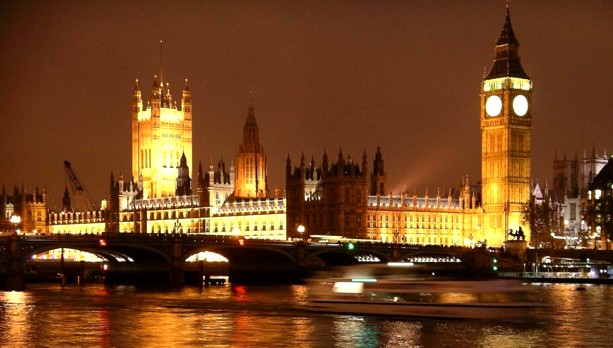
High-achiever Meredith Kercher was born less than one mile south of this famous London landmark
Building An Evidence Mountain
There are really three pictures, not just the one, still to be fully made whole.
- That of Meredith. We believe a family site will soon add to the fine book published by Meredith’s dad.
- That of all of the evidence the court acquired in 2009, which is the sole picture the Italian citizenry takes seriously.
- That of the misleading campaign by the Knox and Sollecito PR shills, leaving some in the UK and US misled.
The Master Evidence List is a key part of the second picture and there are several other media-friendly pages still to come.
Please click here for more
Monday, September 15, 2014
Analysis #1 Of Testimony Of Marco Chiacchiera, Director, Organized Crime Section, Flying Squad
Posted by Cardiol MD
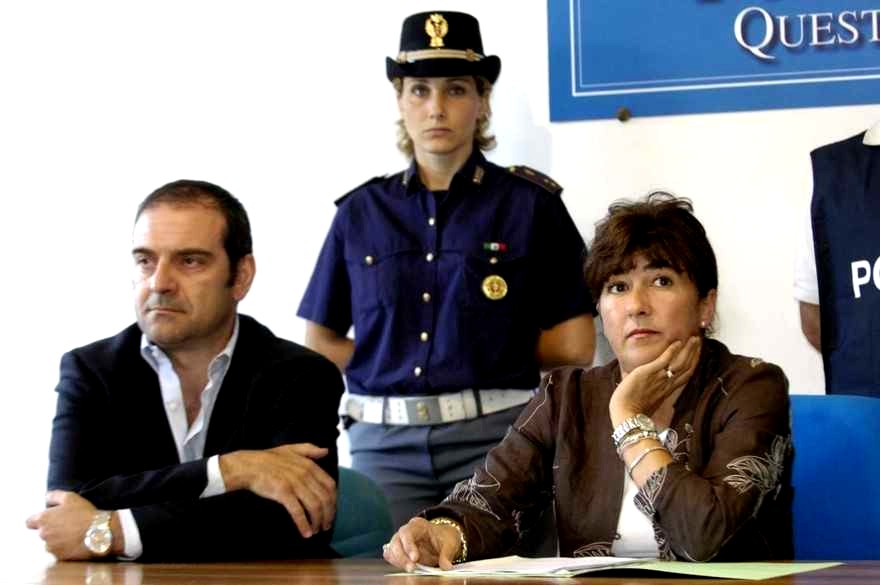
Dr Chiacchiera with Dr Comodi explaining reason for charges in another case
Overview Of This Series
Yet another vital translation which will be posted in the trial testimony areaof McCall’s great Wiki. This again is translated by the ever-dedicated main posterr ZiaK.
Although I graduated as a medical doctor I also graduated as a lawyer, and was often in courtrooms. For this post and the rest of the Chiacchiera series I am wearing my lawyer’s hat to point out what strikes me in Prosecutor Comodi’s questions, Marco Chiacchiera’s testimony, and the cross-examinations by defense lawyers.
Prior Preparations And Procedures
Under the Italian Code, before the beginning of the trial phase in Italy, the parties file a brief, detailing all evidence they want to present ““ the parties have to indicate by name every witness and precisely what these will be asked. The aims include creation of a Record of Admissible Facts.
Also under the Italian Code, both the defendant and the prosecutor can cross-examine each other’s witnesses. The Judge may choose not to admit any testimony that appears patently superfluous, reject irrelevant or improper or irregular questions ““ such as leading questions, and Inadmissible Hearsay ““ and also ask questions to the witnesses and experts.
Ground Covered In Dr Chiacchiera’s Testimony
- (1) He found Knox and Sollecito uncooperative when he asked them questions.
(2) Saw evidence contradicting any lone burglar theory and indicating that the “break-In” to Romanelli’s room was faked.
(3) Phone records and the police investigation into the accused phone activity the night of the murder.
(4) Discovery of pornographic magazines at Sollecito’s house.
(5) Details of how the large knife, Exhibit 36, was collected from Sollecito’s and the evidence that it is the murder knife.
My Assessment Of This Court Exchange
It is immediately obvious to me that this witness is a skilled witness; as such, and given his deep hands-on involvement in the immediate investigation this witness’s testimony is credible. My assessment therefore is that this was a very good and unflinching witness and that Dr Comodi shows no signs of leading the witness or seeking other than a truthful record.
I have seen prosecutors examine witnesses differently but dont believe the resultant record would have been superior. This would have stood up well in any American court.
(GCM=Giancarlo Massei; MC=Manuela Comodi; MaCh=Marco Chiacchiera; GB=Giulia Bongiorno; DD=Donatella Donati; CP=Carlo Pacelli; LG=Luciano Ghirga; CDV=Carlo Dalla Vedova; FM=Francesco Maresca)
Public Prosecutor Comodi [MC]
MC: Dr Chiacchiera, you carried out your duties where, when, at what moment of the events?
MaCh: I was and am the director of the Organized Crime Section of the Flying Squad and I am the vice-director of the Flying Squad. The Organized Crime Section is a branch of the Flying Squad that deals with “¦ the term, I think that in this place [i.e. the court] it is enough to say that it deals with organized crime. However, I am also the vice-director of the Flying Squad, for which [reason] I deal with, in the case of need, everything that is necessary [for] the various aspects.
{Witness supplies 5 items of relevant information that Examiner should elicit at beginning of examination.}
MC: Can you tell the Court how you became aware of events, who called you, when you became involved?
{Examiner asks another triple-question}
MaCh: Yes.
{Witness simply answers question as worded by Examiner}
MC: For now, start to tell us, then maybe I will intervene [NdT: i.e. interrupt with further questions] if necessary.
{Examiner, asking no Q, instructs witness, suggesting provisional forbearance if witness does not make interruptions necessary.}
MaCh: On the fateful day, at around 12:33, I had gone to the cemetery with my mother. The operations room called me immediately after the discovery of the body.
{Witness begins appropriate narrative response, but Examiner interrupts}
MC: So the 113? [NdT: 113 is the Italian State Police emergency number]
{Examiner interrupts witness with a Q, suggesting witness's receipt of call from an emergency number, but suggests wrong source-number}
MaCh: 110. The operations room of the Questura called me, and informed me of the happenings in an initially obviously very summarized manner. They said to me that there was a suspicious death, a young woman who lived in via della Pergola. I rushed to the place directly in my mother’s car. I didn’t stop by at the Questura, I didn’t go to get the service [i.e. police] car. I got myself taken to via della Pergola. We took about 15 minutes from the cemetery to there, ten fifteen minutes. In the meantime, I phoned the deputy Commissioner Napoleoni, in the temporary absence of the director, Dr Profazio, who arrived later, who was “¦ he was enjoying a period of leave, and with deputy Commissioner Napoleoni we arrived almost at the same time. We arrived almost simultaneously at the premises. Forensics, too, arrived almost at the same time at the premises.
{Witness supplies correct source-number and resumes interrupted narrative response}
MC: The Perugia Forensics?
{Examiner questions witness's correction, as if to verify and to ensure accuracy of court's record}
MaCh: The Perugia Forensics, I highlight, yes.
{Witness emphatically agrees with Examiner's question}
MC:”‹[They were] alerted by you, or ...?
{Examiner pauses mid-Q, inviting witness to guess complete Q, or is interrupted}
MaCh:”‹Alerted by the operations room, and also alerted by me.
,
{Witness responds to invitation, or interrupts with A to assumed complete Q}
MC:”‹So you arrive, and who do you find?
{Examiner's 1st simple Q.}
MaCh: “‹I found there ... there was already deputy Commissioner Napoleoni, there were also a few of Meredith’s co-tenants. There was Amanda Knox, there was Raffaele Sollecito. There were two young men who were, I believe, the friend of the boyfriend of one of the co-tenants. In short, there were a few people who had already been inside the house. There was the Postal Police.
{Witness answers Q in reasonable detail}
MC:”‹In the person of”¦?
{Examiner seeks more detail re specific Postal Police Personnel}
MaCh: “‹Battistelli and another of Battistelli’s colleagues. Inspector Battistelli, with whom there was immediately a discussion in order to understand what were the reasons for his intervention there, because it is not normal to find the Postal [police] in a crime of this sort. And he explained to me immediately what was the reason for his intervention. The origin of the, shall we way of his intervention, was due to the discovery of a pair of cellphones in a period of time, I believe, of an hour, [or] two, I don’t recall clearly, that were one in the name of one of Meredith’s co-tenants and one in the name of, later it [sic] “¦ I mean the SIM [card], obviously, the cellphones’ SIMs, the cards, they were in the name of a co-tenant and the other in Meredith’s [name]. The co-tenant, however, then told us, we then ascertained that both of the cellphones in fact were used by Meredith. And already that was, how shall we say, a first detail on which we began to reflect because, in fact, that was an element than in some way made us [become] immediately occupied/involved from an investigative point of view.
{Witness responds to Q and includes relevant amplifying narrative, anticipating probable future Qs re cellphones}
MC: “‹So, excuse me, also if the Court already, shall we say, knows this, because others have reported it, on this point however, where were the cellphones found?
{Examiner seems to interrupt with simple Q to clarify specific relevant fact not yet reached}
MaCh:”‹Inside the garden of a villa that is in via Sperandio.
{Witness responds appropriately}
MC:”‹In via Sperandio.
{Probably a Q, but implicitly inviting more specificity}
MaCh: “‹A villa that ... I am Perugian, [and] honestly, I didn’t even know there was a villa there. I’m Perugian, and I swear that I would have sworn [sic] that behind there was a wood.
{Witness flounders, seems unable to be more specific}
MC:”‹A field
{Probably a Q, but implicitly inviting more specificity}
MaCh: “‹It [was] the first time that I went in behind there. Instead, I see a marvelous old mansion with an enormous garden that gives ... that is almost adjacent to the street ““ the street that leads towards Ponte Rio. Anyone from Perugia understands me maybe.
{Witness seems to be in informal conversational mode}
MC: “‹From the structure of the fencing/enclosure, could you tell, shall we say, whether it was possible to throw these cellphones from the street, or whether it was necessary to enter the garden itself?
{Examiner engages witness, and asks Q to clarify how cellphones got into that garden}
MaCh: “‹Yes, obviously, we checked that. In fact, immediately, in short, the detail that seemed, how shall we say, of great investigative interest was that [very point], besides other details that I will go [into] a bit [sic], so to speak, also to give the impression of what the immediate impact was that we saw in the moment when we found ourselves in a situation of this type. So, deputy Napoleoni immediately entered inside the house in order to check it for herself. I did it [entered] shortly afterwards, also because [as] you will imagine that in that moment whoever was there had to notify all those who [sic], amongst whom Dr Mignini who was the Public Prosecutor on duty, and immediately give orders so that the correct checks are carried out. Because it was not just a crime scene that had to be analysed immediately: there also had to be, how shall we say, correlated with the information that we had got from via Sperandio ““ because the entry of the Postal [police in the case] originated with via Sperandio. And so we immediately asked ourselves: “Ah, what are these cellphones belonging to poor Meredith doing inside the garden of a villa?” And then And then immediately after, we asked ourselves, obviously, what might be the profile of the possible, or probable, murderer, and we discussed/talked about the crime scene. The crime scene immediately seemed fairly strange to us, if you wish [NdT: literally “if we wish” in Italian, but meaning the same as “shall we say”, “if you wish”, “so to speak” etc.]
{Witness responds to Q with detailed narrative}
MC:”‹Why?
{Examiner asks ambiguous Q, probably wrt crime scene seeming "fairly strange "}
MaCh:”‹Because the door did not show”¦ the entry door to the villa did not show signs of break-in. The we checked “¦
{Witness seems to decipher ambiguity correctly, begins narrative response, but is interrupted by Examiner}
MC:”‹We are not talking about the villa on via Sperandio obviously?
{Examiner interrupts with Q, apparently not comprehending Witness's narratives}
MaCh: “‹For the love of god! It was called a “villa” “¦ (overlap of voices), let’s say the house, of the house on via della Pergola there was no forcing/break-in. We found a forcing on the window. The window is this one, on the side of the house. I don’t know if you’ve seen the house? Anyhow, it is this one on the side of the house that can be seen immediately when you come down the slope from the gate. Logically reconstructing the thing, a hypothetical prowler [NdT: literally “ill-intentioned person”] who entered the house, breaking the glass with a rock - because inside the room, which was Romanelli’s room, which was the, shall we say, hypothetical arena of the entry, was completely in utter chaos. For that reason, what should we have hypothesized? That the hypothetical prowler took a rock, managed to throw the rock; the shutters, the external ones, the external shutters were not “¦
{Witness is exasperated at Examiner's apparent incomprehension, is repeating his previous testimony, but is interrupted by Examiner}
MC:”‹The dark-green wooden ones?
{Examiner interrupts with Leading Q re colour of external shutters. Now begins a confused and confusing colloquy. The arrangement of Filomena Romanelli's window, with Outside, and Inside Shutters, the Broken-Glass-Frame in-between, and the glass-splinters on the window-sill is complicated and needs a picture-exhibit that the witness can refer-to; this is apparently not provided, leading to the confusions}
MaCh:”‹The dark-green wooden ones were half shut, for which reason [he] must have had an aim like “Pecos Bill” [NdT: a cartoon Wild West cowboy], takes aim and throws that rock, smashes the window. After, he climbs up and does a turn on the little slope, and has to clamber up towards the window on the smooth surface, it seems to me, that from the ground up to the window there are two and a half metres-three [metres]. And then would have said: “bah, in short” [sic]. Yeah, well, the thing seemed to us…. in short, the first hypothesis that the investigator normally does, finds a level of unlikelihood of this kind of happening. After which, we looked at the house and we saw that an entry of a potential prowler [ill-intentioned person], still reasoning on the hypothesis”¦
{Witness amplifies narrative response but is interrupted by Examiner}
MC:”‹Of theft.
{Examiner inappropriately interrupts, incorrectly guessing what witness was about to say}
MaCh: “‹Of theft ending badly. Of theft that then degenerates because the burglar in some way thinks that he will find no-one in the house and instead finds a person, and then it degenerates “¦ We saw that there were easier means of entry, without wishing to bore you, but behind the house there was the possibility of climbing in a much easier way, without being seen by people that might have passed in the road. Let’s remember that, in short, it was not very late; quite the contrary. Normally people passed there, for which reason, if [he] had done it, the thing would probably have been seen. That thing there, as an hypothesis, we didn’t immediately discount it, that’s clear, because it’s a good rule to never discount any hypothesis. But we immediately considered that it was not a priority.
{Witness corrects Examiner's wrong guess, amplifies and seems to end narrative response}
MC:”‹Dr Chiacchiera, I interrupt you. (The witness is shown an exhibit.)
{Examiner, seems to acknowledge her habit of interruptions without actually interrupting, while introducing an unspecified exhibit. This introduction seems very informal, because Exhibits are normally identified by an assigned title.}
MaCh:”‹Ah! I didn’t remember it as being so big.
{Witness recognizes unspecified exhibit}
MC:”‹Precisely! You saw it? This is the rock that ...
{Examiner engages witness, stating it is "the rock".}
MaCh:”‹Yes, but it has been some time I have not, how shall we say, yes, I saw it. Absolutely.
However, it’s big, it’s huge.
{Witness engages Examiner, commenting on how large the rock exhibit is}
MC:”‹Do you consider that it could be this?
{Examiner ambiguously (what are "it" & "this "?) asks witness's opinion}
MaCh:”‹I believe so.
{Witness seems to overlook ambiguity of Q with vague A)
MC:"‹I try "¦
{Examiner begins to speak but is interrupted}
Judge Massei [GCM]:”‹How?
{Court interrupts as if to ask Q how Examiner 'tries'}
MC:”‹It is this. Yes, it is this one that was collected, yes, that was found.
{Witness seems to confirm that exhibited rock is the rock found in Filomena's room}
GCM:”‹So the rock is shown. [NdT: an “aside” for the court records?]
{Court formally announces admission of rock-exhibit, seemingly trying to reduce confusion caused by informal dialogue}
MaCh:”‹Inside the room where we then found the rock…
??:”‹But what was the question about the rock?
{Witness amplifies that rock had been found in a room, but enquires re rock Q, exposing confusion caused by informal dialogue}
GCM:”‹If this was the rock. And the witness said ...
{Court begins explanation to confused witness}
MaCh:”‹I said yes. Yes.
{Witness interrupts Court - confusion reigns}
GCM:”‹You saw it? You saw the rock?
{Court asks witness 2 Qs, trying to clarify that 'it' refers to 'the rock' that witness saw.}
MaCh:”‹Yes.
{Witness confirms that witness had previously seen the rock introduced into court as an unlisted exhibit.}
GCM:”‹When you saw it, where was it?
{Court proceeds to clarify confusion re where the rock was when witness originally saw the rock}
MaCh:”‹The rock [was] in the room of Romanelli.
{Witness specifically testifies, for witness's first time, that when witness originally saw the rock, the rock was in Filomena Romanelli's room}
GCM:”‹How far from the window? Can you say?
{Court continues to seek clarification using double-Q.}
MaCh: “‹A few centimetres [NdT: “un palmo” = “a hand’s width”] from the window sill, under the window, from the wall where the window is.
{Witness testifies clearly in answer to Court's 1st Q of above double-Q.}
GCM:”‹So from the internal perimeter wall, from where the window gives onto it, a “hand’s breadth”. So 20 centimetres…
{Court apparently begins to seek verification of witness's testimony, but is interrupted}
MaCh:”‹Mr President ....
{Witness begins to Interrupt Court}
GCM:”‹... away from it approximately.
{Court finishes his interrupted statement}
MaCh:”‹Yes.
{Witness agrees with Court's completed statement}
GCM:”‹And this is the rock. You remember it.
{Court states his understanding in form of Qs.}
MaCh:”‹Yes, yes, yes, yes. That is the rock.
{Witness impatiently agrees with Court's understanding}
MC:”‹At least as far as size and colour [are concerned], it corresponds thus to the one that was collected [as evidence].
{Examiner makes statements in form of Q, seeking verification of resemblance of exhibit-rock to original rock}
MaCh:”‹At least as far as size and colour [are concerned], it absolutely corresponds. If it was collected, I think that ...
{Witness begins narrative agreement with statements of Examiner, but is apparently interrupted by Examiner}
MC: “‹Very well. WITNESS [sic? Should be MaCh?] and Romanelli’s room was a complete shambles. The clothes were on the floor, the glass was strangely on top of the clothes, the [glass] shards were strangely on top of the “¦ on the windowsill, let’s put it that way.
{Apparent Transcriptional confusion attributing to interrupted witness narrative the interrupting .statement of Examiner}
MC:”‹The outside one.
{Examiner seems to amplify statement of Examiner wrt which window-shutter witness had been referring-to}
MaCh: “‹The outside one, precisely. The one that is between the shutters and the shutters [sic. NdT: “imposte” in Italian, but this can also mean shutters, or flap, as in the inner “scuri” shutters, or he may mean the window-frame itself, with the window-panes, given his following description], the green shutters and the shutters, the broken ones in short, where the glass is. The shutters ““ the wooden ones. The rock was a bit too close with regard to the wall if I [were to] throw it from least two metres. Unless it was lobbed [i.e. thrown in a high arc]. But in that case it’s rather unlikely that it would smash the glass. For that reason, I repeat, in the context of immediate likelihood, this one “¦
{Witness agrees with Examiner that he was referring to "The outside one", continuing with narrative of reasoning, but is interrupted by Examiner…}
MC:”‹Yes, it’s true. These are considerations. However they are considerations, shall we say, that refer [sic], because they are reasoning/lines of thought that are formed in the “immediacy” of the events [NdT: i.e. “in the immediate aftermath”. NOTE: throughout the text, a number of speakers use “immediatezza” (lit. “immediacy”) to convey a number of meanings, from “in the immediate aftermath”, or “in the immediate surroundings”, or “very soon after”, etc. I will translate them appropriately according to the context, without further explanation of the use of “immediatezza”], in order to proceed in one direction rather than another.
{Examiner, interrupting witness, apparently agreeing with witness's reasoning. While Examiner is apparently stating his own argumentative reservations re the possible evolution-in-time of witness's changing lines of reasoning, he is interrupted by Giulia Bongiorno, Sollecito defense lawyer:}
Giulia Bongiorno [GB]: “‹I never like to interrupt an examination [of a witness], however if one wanted, between the Public Prosecutor’s hypotheses, to do that [sic] of demonstrating that from a ballistic point of view it is not possible, then the ballistic expert should be called.
{GB interrupts Examiner to comment that Witness and Examiner are expressing opinions on Ballistics that require the testimony of a Ballistic Expert.}
MC:”‹But in fact, his considerations are not the considerations of an expert: they are the considerations of an investigator who made certain deductions in the immediacy of the events.
{Examiner argues that witness's testimony is that of an investigator's temporal train of thought.}
MaCh:”‹It happens to us too, at times, to reason/think rationally “¦
{Witness joins colloquy, amplifying Examiner's argument.}
GCM:”‹These reasonings/deductions, then determined your investigative activity in one direction rather than in an “¦?
{Court seems to invite further amplification by witness}
MaCh: “‹Yes, obviously, Mr President. I was trying to ... (overlap of voices) it is a premiss/basis to be able to then, how shall we say, reach ““ I won’t say conclusions ““ but in order to try to understand what our way of broaching the thing was, there and then. We had, I reassert, reasoned immediately also on via Sperandio. So the first thing, I may say, [was] the unlikelihood, or at any rate it was not the top priority hypothesis, the one of a prowler/ill-intentioned person entering. The open door without signs of break-in. But above all, a young woman who is [sic] probably killed in her own room, nude or almost nude, with a wound of that type, in a lake of blood, covered with a duvet. I repeat, the door was not smashed/wrecked, there’s a broken “¦ a window broken with a thrown rock, how can I say, it’s obvious that we immediately found this situation as “¦ (overlap of voices).
MaCh:”‹”¦ particular.
{Witness further amplifies narrative}
GCM:”‹You formed these considerations, and what did they lead you to?
{Court asks simple Q.}
MaCh: “‹That very probably the author or authors knew the person, or at any rate that the author or authors did not enter “¦ did not enter from the window-pane of that window.
{Witness responds with his conclusion that the authors of the faked break-in did not enter from the window-pane of that window.}
GCM: “‹Excuse me a moment, just to give some guidelines, but of the evaluations that the witness is expressing, obviously it’s not that they can be taken account of, however we will acquire them [for the trial files] in order to understand the investigation activities, the appropriateness of the investigations that were carried out, directed in one way or in another, there you go. However, maybe, “¦ there you go, yes, maybe if we can manage to keep with the bare essentials this will help everybody.
{Court proceedings seem to have been diverted into a free-for-all colloquy, with multiple participants chiming-in, and creating confusion. Court-President, GCM, now politely intervenes, apparently trying to restore order, ruling that the professional evaluations made by the witness, testified-to by the witness, should be admitted for the trial files. The appropriateness of the witness's evaluations can be dealt with separately and later.}
_________________________________________________
This segment of Chiacchiera’s Testimony re the Crime Scene, which he believed had been remodeled by the criminals to dupe Investigators into believing that there had been a burglary, committed by a single criminal, is paused here because it is so prolonged.
Analysis of Chiacchiera’s Testimony will continue in a future post.
Tuesday, April 29, 2014
Why Final RS & AK Appeal Against Guilty Verdict May Fail: Multiple Wounds = Multiple Attackers
Posted by Our Main Posters
Reports From Italy On Why AK & RS Appeal Failed
The Nencini Report has been released and we are seeing to its translation right now.
Meanwhile journalists in Italy have these reports which convey the very implacable, damning tone. There was nothing accidental about Meredith’s death; Knox premeditated it all along.
First report
From Il Messagero kindly translated by Miriam:.
FLORENCE - The knife that was seized at Raffaele Sollecito house is the knife that killed Meredith Kercher, and the blow was delivered by Amanda Knox. So writes the President of the Court of Appeal of Florence, Alessandro Nencini, in the motivation report of the sentence that was passed on Jan. 30th that saw Amanda Knox sentenced to 28 and a half years and Raffaele Sollecito to 25 years.
Over 330 pages in which the court covers the appeal and explains the conviction. Starting with the knife considered “not incompatible with the wound that was carried out on Meredith Kercher. “In the present case, writes Nencini what counts is the accessibility of the weapon by the accused, it’s concrete portability from house to house, it’s compatibility with the wound, and the presence of Meredith’s DNA on the blade. All of these elements ascertained by the court lead to the conclusion that the knifed evidenced as no. 36 was one of the knifes used in the attack, and was the knife that Knox used to strike the fatal blow to Meredith’s throat.”
The court retains to have sufficient evidence of “certain reliability” of Rudy Guede (convicted to 16 years) Amanda and Raffaele in the house where Mez was killed, on the night between the 1st and November 2, 2007 in 7 Via della Pergola “in the immediate phases following the murder.” The Court then tells how she was immobilized and Mez “was not able to put up some valid resistance because she was dominated by multiple assailants and cut at the same time with the blades of several knives.”
Rejected therefore is the defense’s strategy of both of the convicted, that have always maintained that the killer was only one.: the Ivorian Rudy Guede.
Second report
Bullet points from various Italian media.
- The big knife from Sollecito’s house held by Amanda Knox caused the fatal wound to Meredith while the other was held by Raffaele Sollecito.
- There is strong “multiple and consistent” evidence of all three in the house immediately following the murder. All three worked to suppress Meredith.
- There was an escalating quarrel between Knox and Meredith leading to a progressive aggression and murder with sexual components.
- Between Amanda and Meredith there was no mutual sympathy and Meredith harbored serious reservations about the behavior of AK.
- The biological trace found on the bra clasp that Meredith Kercher was wearing the night she was murdered was left by Raffaele Sollecito
Third report
No especially accurate reports in English have appeared yet and the erroneous “new trial” is still surfacing. Andrea Vogt tweets that she will be posting an analysis soon.
The mischievous defense-inspired “sex game gone wrong” and “satanic theory” mantras are still widely showing up in the duped media, but are nailed hopefully finally in this new report.
Judge Nencini has closely followed and endorsed the “from all angles” Massei trial analysis, but with the inclusion of some more credible explanations from Prosecutor Crini which Judge Micheli had also espoused back in 2008.
In particular, Rudy Guede is not now highly improbably seen as the one initiating the attack on Meredith, and sex was not at all the primary driving force for the attack (the prosecution never ever said it was). Knox carried the big knife from Sollecito’s for a purpose.
The bad blood between the girls resulting from Knox’s crude, brash, very lazy, drug-oriented behavior was well known in Meredith’s circle. All of them had backed away from her, as also had her employer and the patrons in his bar.
There was a probable theft of money by Knox who was unable to account for a sum similar to what Meredith would have stashed away for the rent and that is seen as the probable spark for the explosive argument and attack.
Fourth report
Barbie Nadeau in The Daily Beast
Amanda Knox apparently did not kill Meredith Kercher in a “sex game gone wrong,” as had been previously decided by a lower court in Perugia, according to a Florentine appellate judge who released today a 337-page document explaining his decision to convict Knox and her erstwhile Italian boyfriend, Raffaele Sollecito, for Kercher’s murder. Rather, the judge claims, Knox allegedly killed Kercher, her 21-year-old British roommate, because she didn’t like her.
All Italian courts require judges to explain the reasoning behind their rulings, and it likely represents the penultimate step in a seven-year case that has seen Knox and Sollecito first convicted in 2009 then acquitted in 2011 then convicted again in January 2014. Rudy Guede, an Ivory Coast native who was also convicted for his role in the murder back in 2008, is serving a 16-year jail sentence. He is currently eligible to apply for work furloughs from prison.
Judge Alessandro Nencini, along with a second judge and six lay jurors, were tasked with hearing a second appeal that began in September 2013 after Italy’s high court threw out the acquittal that set Knox and Sollecito free in 2011. Italy’s high court cited “inconsistencies” and “legal mistakes” and tasked Nencini’s court with hearing the appeal again. It was not a retrial per se, but rather a fresh look at the appeal process that freed Knox.
Nencini decided that the appellate court that set Knox free erred in evidentiary and legal matters. That court will now have to rule definitively on the case, using Nencini’s reasoning and whatever appeal Knox and Sollecito file for their final judgment. If the high court accepts Nencini’s verdicts, the two will be required to serve their prison sentences in Italy. Knox has vowed she will not return to Europe, but Sollecito, unless he escapes, won’t be as lucky.
The court’s explanation of its decision comes down hard on the first appellate court that overturned Knox’s guilty verdict, at times seemingly scolding them for misapplication of penal codes and for throwing out witness testimony without explanation. “It was an operation of evaluating evidence with using logic,” Nencini wrote, accusing the first appellate court of essentially throwing out testimony that allegedly proved Knox’s involvement, but keeping testimony that supposedly supported her innocence.
He used Knox’s prison diary as a prime example. “Look at the contradictions in the evaluation of the diary written in English by Amanda Knox,” he wrote, referring to a handwritten prison diary taken fromKnox’s cell as part of the investigation to determine why she accused her pub boss Patrick Lumumba of Kercher’s murder during early interrogations. “On one hand, the appellate court of Perugia completely devalued the writings when she admitted wrongdoing by accusing Patrick Lumumba. On the other side, they valued it when she defended herself.”
Nencini also ruled that there was plenty of forensic evidence tying Knox and Sollecito to the crime scene, writing “they left their tracks in the victim’s blood” more than once in the document. He accepted testimony that supported the theory that a knife found in Sollecito’s apartment was one of the primary murder weapons, and he reasoned that a second knife was also used that matched a blood stain left on Kercher’s mattress.
The first knife in question was the only hard evidence reexamined in the second appeal, and forensic experts ruled that a previously untested spot on the knife’s handle consisted of 100 percent Knox’s DNA. An earlier court heard testimony that a tiny smidgeon of DNA on the groove of the blade was Kercher’s, but the first appellate court agreed with witnesses who testified that the sample was too small to be considered a perfect match. The second appellate court not only considered the knife to be the murder weapon, it also ruled that Knox “plunged the knife into the left side of Kercher’s neck, causing the fatal wound.”
The second appellate court also reasoned that Kercher’s bra clasp, which had been cut from her body after she was killed, had Sollecito’s DNA on the tiny metal clasp. “The biological trace found on the bra clasp that Meredith Kercher was wearing when she was assassinated belonged to RaffaeleSollecito,” Nencini wrote, agreeing with the judge in the original murder conviction. “The clasp was manipulated by the accused on the night of the murder.”
The court also scoffed at certain rulings laid out by the first appellate court, saying that the court’s reasoning that it would have been easy for “a young athlete” like Rudy Guede to scale the wall and enter the apartment, was borderline racist.
Nencini also ruled that with regard to motive in the murder, it was subjective and personal. “It is not necessary for all the assailants to share the same motive.”
The court picked out small details of Knox’s presumably errant testimony, including how she told police the morning Kercher’s body was found that Kercher always locked her door “even when she takes a shower,” which was later contested by the girls’ other roommates.
Nencini also clearly believed ample forensic testimony, presented by experts examining the original autopsy, that Kercher was killed by more than one person. “”She was completely immobilized when she was murdered,” he said, reasoning that Guede could not have acted alone, and instead likely held her back as Sollecito and Knox knifed her.
The judge also pointed out incongruences in Knox’s testimony about the night of the murder, but noted problems with the other witnesses, which included a homeless man, an elderly woman who said she heard screams. Still, he ruled that Knox’s accusation of Lumumba is vital evidence against her. “It is impossible to separate the two acts,” he wrote.
Using Nencini’s reasoning, Knox’s lawyers now have the roadmap for planning their final appeal to Italy’s high court, likely later this year or in early 2015. However, this same high court threw out the acquittal in the first place, so Knox may need more than luck to walk free. If she is definitively convicted, she will likely face an extradition order to come back to Italy to serve out her sentence. There are very few legal loopholes that would allow an American citizen to escape a court decision by a country, like Italy, that shares extradition treaties with the U.S.
[Judge Massei at crime scene; report says why Knox & Sollecito appeal against his 2009 verdict has failed]
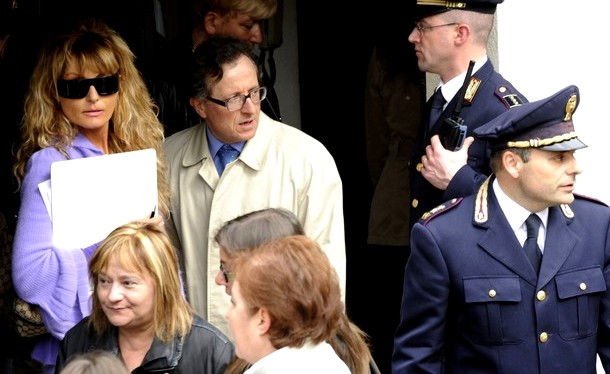
[The Supreme Court in Rome is expected later this year to confirm this outcome]
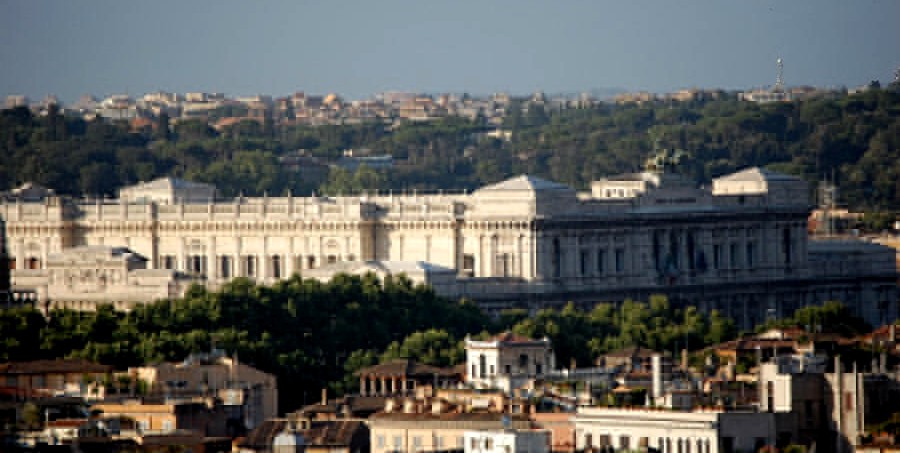
Wednesday, April 16, 2014
The Incriminating Bathroom Evidence: Visual Analysis shows the Footprint IS Sollecito’s
Posted by Machiavelli
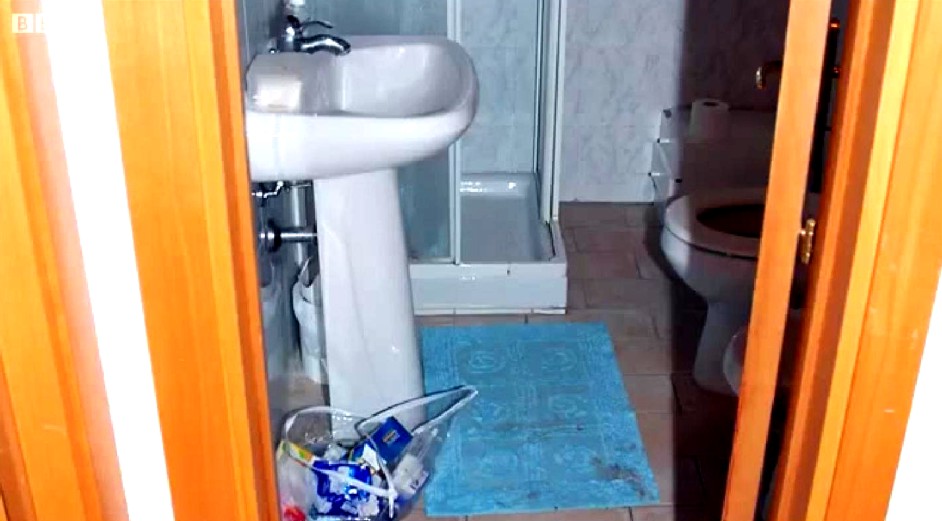
[Please click on each image for a larger and more high-resolution version]
The sheer depth and width of the hard evidence
The defenses really don’t want you to know this: in both width and depth, the full panoply of the evidence against Knox and Sollecito is absolutely overwhelming.
As we remarked in our post below there are far more and far stronger evidence points than UK and US courts normally require for conviction. But only the trial panel of judges observed anything like their full array.
The 2010 Massei Trial Report (which the Nencini Appeal court validated this past January) is a SUMMARY of what was presented to the judges in the courtroom. Those presentations in court were in turn something of a SUMMARY of the hard evidence buried in all the evidence files and the minds of witnesses.
Italian media SUMMARISED for Italians what was to be seen in the courtroom and to be read in the Massei Report. They were barely able to do even summaries for the 1/4 of all the trial hearings that were not open to the media or the public.
UK and US media for the most part didn’t even bother to provide comprehensive summaries (the very fine on-the-spot reportings of Andrea Vogt, Barbie Nadeau and Ann Wise were the main exceptions).
So in effect people in the UK and US attempting to follow the story didnt for the most part receive even a summary of a summary of a summary!
Not one US or UK newspaper or TV network translated the Micheli Report, or the vital Massei Report, or the Supreme Court appeal, or the Supreme Court outcome - only the (mostly professional) translators on PMF dot Org did all that translation.
This post is another example of how far down - beyond even Massei - it’s possible to drill into the evidence, and see it still hold up.
Some past posts on TJMK drilled down to similar depths, on the knives, on the DNA, on the mixed-blood traces, on the phone-events, on the motives and psychologies, and so on. All that evidence too all held up.
Visual analysis of the bathroom-mat footprint
This post mainly consists of high-resolution pictures and measurements. Presented like this, the pictures and measurements largely speak for themselves, and show the real strength of the bathroom-mat footprint evidence.
You will see that as SomeAlibi previously concluded using other methods, this footprint was quite undeniably Sollecito’s. It bears no similarity at all to Rudy Guede’s.
Please click on all images for larger versions in scalable PDF format
1 . [Below] the bathmat and the print, with measurement reference
2 . The bathmat print and the surrounding area
3 . The bathmat print (photo from Polizia Scientifica).
4 . The bathmat print, with vertical and horizontal sizes, from Rinaldi’s report
5. The bathmat print, photo with enhanced contrast.
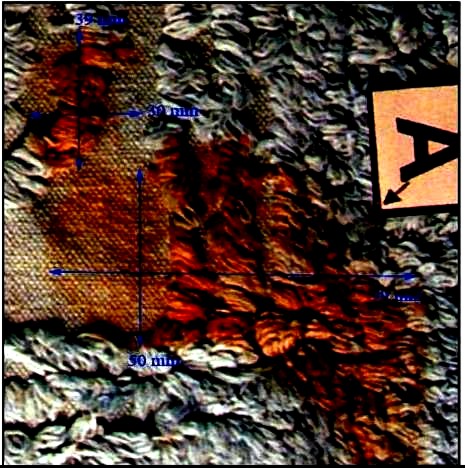
The photo above was modified by highly enhancing contrast.
6 . Enhanced contrast helps to spot some features
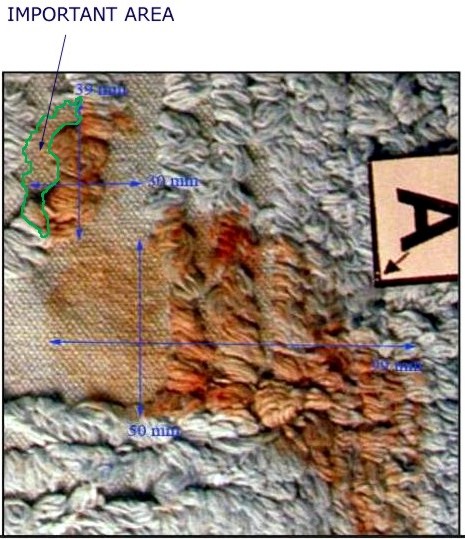
Contrast may help to highlight especially some parts of the print outline.
For example the area on the left labeled as “important area” in the picture (which was “forgotten” in the notorious photo elaborations disseminated by the ‘Friends of Amanda’ group), shows the actual left outline of the “˜big toe’ of the bathmat print.
The toe includes the area indicated in this picture (here the picture is shown again in its original colours).
7. The bathmat, with enhanced contrast
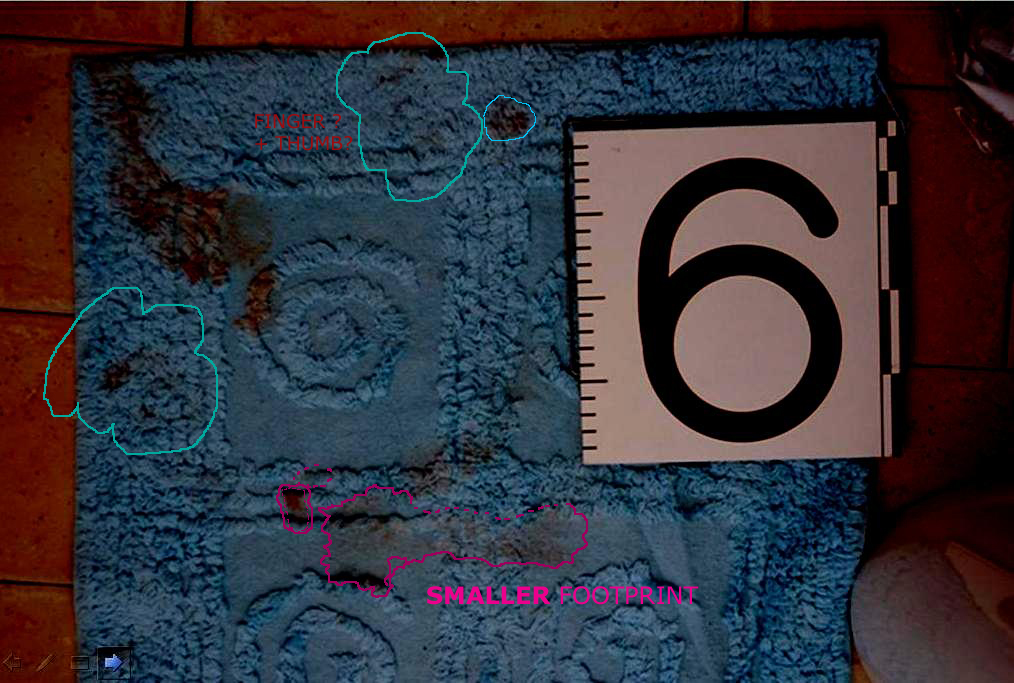
The contrasted image is showing the presence of other stains
There are other stains on the carpet (about another 10, factually situated in one half of the mat area), and also there shows a second diluted footprint (apparently from a foot of smaller size).
8. The selection of a set of red colour shades, outlined by an automatic outline generator
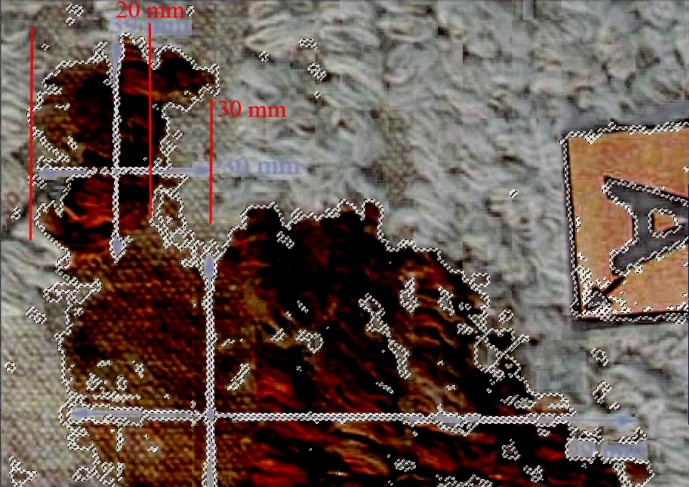
Shows the shape and the possible “˜outline’ of the stain
Reference measurements indicate the width of the “˜big toe’ in millimetres.
9 . A hand drawing of the outline (detail).
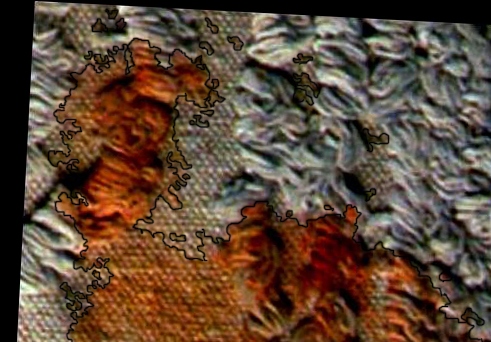
The photography above was modified
The modifications are: +28% contrast, -8% luminosity, + 20% colour saturation, from the original.
An outline has been drawn manually on the photoshop image, trying to be as faithful as possible to the actual stain.
You can notice that, apart from some minor “˜disputable’ very faint areas (such as the area between the toe and the metatarsus) there are only minimal differences between an automatically generated outline and a manually drawn one.
The shapes of the “˜big toe’ are extremely similar in both contours (images 8 and 9), in fact all meaningful features are basically identical.
We consider this manually drawn outline as good for comparison.
10 . The complete hand-drawn outline
11 . Minor detail: small dots separated from the main stain
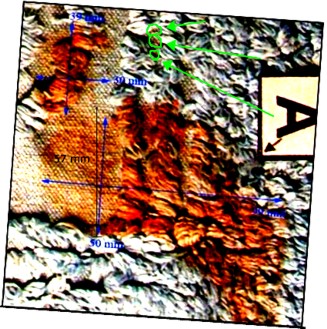
Observe the small red ‘dots’ in the picture above
Although we can’t draw any conclusion about their possible significance, we note the existence of these very small “˜spots’ of a faint red colour shade, separated from the big stain.
They are detected by the computer generated outline above, and that we also see as distinguishable with the naked eye thus we considered them in drawing manually the outline.
We don’t draw any conclusion about them; but because of their sensitive position (they may suggest a “˜small toe’ mark) we take note of them.
The green arrows in the picture point out their position (green circles).
12 . An image in electronically modified colours
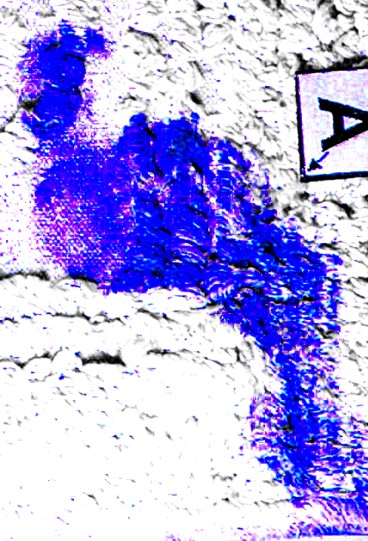
Distribution and intensity of the colouration
As a part of the preliminary study of the stain, we also produced this image above where the computer assigned an artificial colour to an array of shades of ‘red’, thus allowing to further isolate the stain from the background for further assessments about its shape.
This picture shows the distribution and intensity of the colouration. (note: the existence of some above mentioned tiny marks is recorded by this technique too)
13 . The bathmat has a spiral-shaped relief decoration
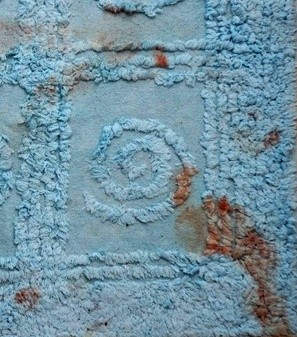
The footprint’s toe obviously balancing on top of the relief decoration.
We think the outline of the “˜toe’ mark of the bloody footprint is affected by the shape of the decoration, in particular the missing part of the toe on the right side, which is remarkably coincident with the margin of the decoration.
So that on that side there is a striking correspondence between the outline of the “˜negative area’ ““ the fabric surface around the spiral, which is lower ““ and the big toe’s outline
This indicates that the outline of that mark on that side was affected by the decoration margin, thus the print there has a “˜missing part’. So the “˜crooked’ bloody area in fact follows the margin of a larger toe.
Because of such coincidence, we can logically assume that the actual shape of the big toe mark appears to be part of a big toe, with larger surface which left its print only partly because part of its surface did not have contact with the fabric, in correspondence of the “˜negative area’.
14. The “negative area”
15. Mat decoration in relief and the toe mark
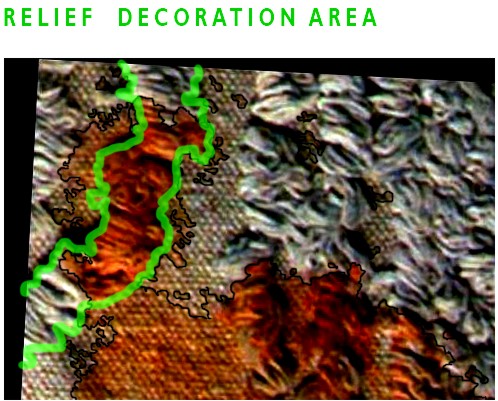
Observe above one single, unitary stain
The remarkable coincidence between the outlines of the decoration in relief and of the toe mark is shown in the picture above.
The rough contour of the print obtained through a smooth curve highlights the shape of the big toe.
Part of the relief decoration outline coincides with the toe mark outline, which shows, highlights and explains how all parts of the red toe mark, that you can see left of the relief decoration, they all belong to one single, unitary stain.
Thus we can deduce that the “missing” area on the right of the toe is determined by the decoration, and coincides with the negative area.
16. Picture (by Kermit) showing a rough shape of the stain
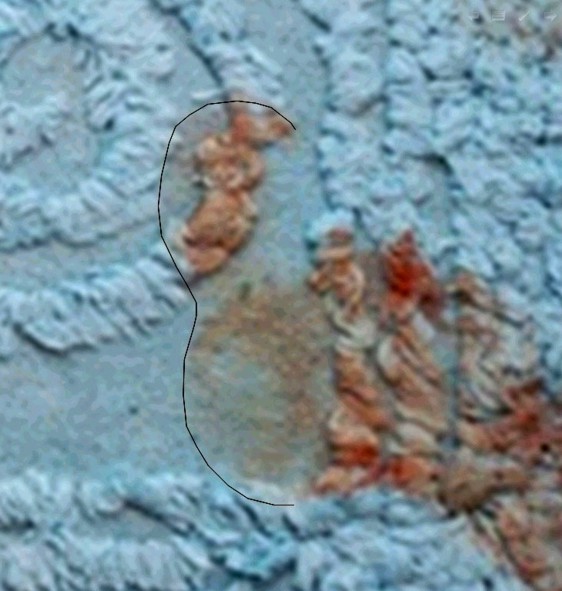
Observe shape, curvature and size
This drawing by Kermit above highlights the rough shape, curvature of left margin and overall size of the big toe.
17. Rudy Guede’s sample print
A copy of this picture together with one of Sollecito’s print at the same scale will be used for comparisons.
18 . Raffaele Sollecito’s sample print
A copy of this picture together with one of Guede’s print at the same scale will be used for comparisons.
19. Part of Rudy Guede’s sample print with Rinaldi’s reference measurements
20. Part of Sollecito’s sample print, with Rinaldi’s reference measurements:
21. Bringing all photographs down to the same scale
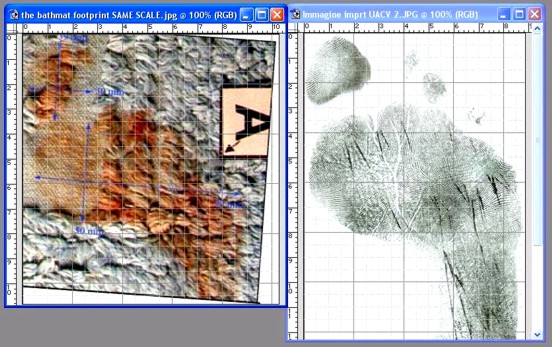
An accurate exercise of scaling was done
This was based on Rinaldi’s referenced pictures. Each one of the Rinaldi’s sample pictures has multiple measurements on several points of reference which allow a high precision determination of their scale and sizes, and thus comparison at the same scale.
In order to further increase scaling precision, the scale was calculated previously and separately for each comparative measurement in the three photos; this was done multiple times for each measurement and the average was picked in order to reduce error as for statistical measurement method.
The resulting final error in the scale is extremely small, far below a threshold of significance that could affect comparison (which was set arbitrarily at 1%, but it’s probably significantly higher, while the actual error is much lower).
In other words, the scale error that may affect your screen pictures will be definitely smaller than any possible perceivable (either significant or tolerated) difference that would be noticed or that may affect the attribution of the stain, when this is compared to the sample.
22. The hand drawn outline is shown again here
23 . The outline (matched scale) overlapped on Sollecito’s sample footprint
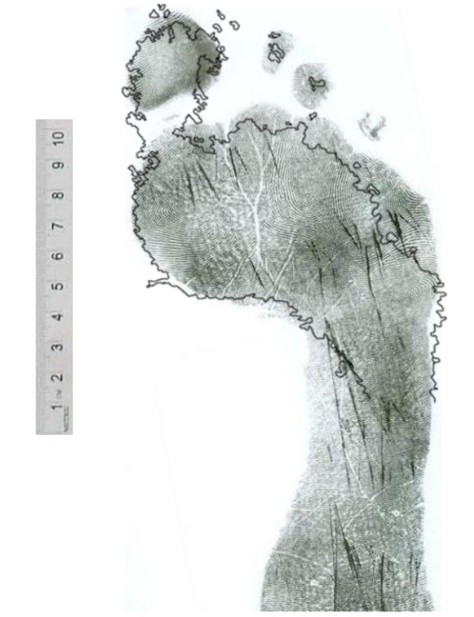
The array of compatibilities with Sollecito
The bathmat stain does not seem to have major incompatibilities with Sollecito’s print; it shows rather an array of compatibilities that can be perceived visually.
One interesting feature is the shape, size and position of a ‘big toe’, that appears as a remarkable coincidence; the toe also has a kind of cleft (see 28 below) on the curvature of its left margin. Another outstanding coincidence is the curvature of the plantar arch on the left.
24 . The same outline overlapped on Guede’s footprint
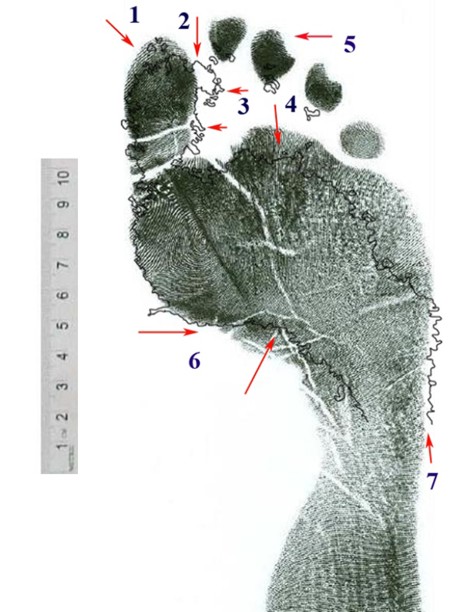
Compare with Guede’s - matched scale.
If you look at the overlapping of the stain outline (see pic 22.) with the sample of Guede’s print (see pics 17. 19.), you may notice 7 major differences, showing a failure of compatibility. Those differences are indicated by numbers (1-7) in the picture .
Each one indicates an area of major difference between the outline of the bathmat stain and the outline of Guede’s sample print. Those measurement differences are remarkably larger than those that can be detected on the overlapping with Sollecito’s sample print.
On the other hand, the compatibility between Sollecito’s print and some very peculiar aspects of the bathmat print (such as a 30mm wide and short toe) were absolutely remarkable.
The differences between the bathmat stain and Guede’s print are :
1) Toe mark of stain is significantly SHORTER than the big toe in Guede’s sample print (a difference of about 7 millimetres). Some people may want to attempt an objection, by suggesting that such a difference may be just a consequence of the position chosen for the overlapping, that maybe the bathmat print was just positioned too low in the picture, the problem may be solved by shifting it up about 7 millimeters so as to make the tip of the bathmat toe ‘coincide’ with the tip of Guede’s print toe.
However, such objection wouldn’t work; it’s a wrong argument. In fact the only possibly correct position for overlapping the bathmat stain outline is determined by the left curvature of the ball of feet and plantar arch (the area of the picture near number 6), which is by the way the most clearly outlined part of the bathmat stain. If you shift the bathmat stain upwards, the outline will miss the match with the curvature of the left margin of the ball of the feet. You will notice that the plantar arch in this area is already very incompatible with Guede’s plantar arch. It tends to become even more incompatible the more you shift the bathmat stain outline towards the toe.
The problem has no solution, since the more you shift the stain outline upwards (in the direction of the toe) in an attempt to make it look more ‘compatible’ with the length of Guede’s toe (or with an upper margin) the more it will become incompatible with the plantar arch. In order to limit the incompatibility of the plantar arch, and in order to keep an overlapping of at least the left margin of the ball of the feet, you need to place it as shown in the picture, this is the position of ‘maximum’ compatibility between the bathmat stain and Guede’s print. Conclusion: the bathmat toe is too short.
2) Toe mark of stain is TOO WIDE (30 mm). It is much wider (30 mm) than Guede’s toe. The number 2. indicates the protruding mark at the upper right, the mark which Giulia Bongiorno desperately insisted on calling a “second toe” mark. In fact, not only would the mark miss completely any hypothetical Guede’s ‘second toe’ in any possible position of the print; also you may notice (highlighted by pics 8. and 9.) how it is not a “mark” itself, but actually it just part of the same area which is entirely continuous in shape and coloration with the rest of the toe mark, and - the most remarkable feature - its right outline is coincident with the outline of the spiral-shaped relief decoration, so that you can reasonably conclude that it is determined by that (the missing area at the lower right of the ‘big toe’ is determined by the existence of the “negative area” of the bathmat decoration).
Conclusion: the bathmat stain has a wider toe mark, however one likes to call it (“big toe”, or “big toe + second toe”) that fails to match any possible part of Guede’s print. The bathmat print is clearly different and incompatible with Guede’s print. It simply cannot be overlapped to any part of Guede’s sample print. Such area is a very significant difference that points outright to incompatibility between the stain and Guede’s print.
3) The toe mark is larger also in the area located at the lower portion of the toe. The toe of the bathmat print in fact has a ‘right margin’ which actually has some additional small marks, small drops protruding towards the right, like droplets maybe produced by the wet cotton fibres of the part in relief which protrude towards the right. This tends to suggest the toe area of the stain may in fact be considered wider: the object that produced it was definitely wider than 22mm, in this area of the toe as well. So also a look at this area confirms that the bathmat stain is wider than 22-23 mm (more towards 30 mm) not just when measured at the upper corner (number 2.) but also at its “lower” parts; here, the small marks caused by the liquid suggest that a larger surface has squeezed liquid from some fabric threads leaving some trace also on the lower area.
4) Bigger incompatibility of Guede on the metatarsus front outline. This area is the front outline of metatarsus: the stain is almost 1cm shorter than Guede’s metatarsus. This happens when you chose the overlapping so as to make the left outline and plantar arch (6.) of metatarsus coincide, as in the picture. Sollecito’s sample print also shows some difference from the stain in this area (pic. 23.) but the difference between the stain and Sollecito’s print is significantly smaller than what you can see in Guede’s print.
5) There are NO SMALL TOES in the bathmat stain. Small toes are completely absent from the bathmat stain (while the tiny blood marks around the stain don’t coincide with their expected position if it was Guede’s print). Such lack of small toes is a peculiarity of the bathmat print. This is a remarkable difference from Guede’s print, and at the same time, a considerable analogy with Sollecito’s print. In fact one outstanding feature of Guede’s print is the evidence that Guede places a big load of weight on his small toes while instead Sollecito has a posture with a weight distribution with the contrary tendency, and obviously he almost does not touch the ground with his small toes.
Thus, Guede’s small toes are all very well pressed on the ground and thus, we can reasonably infer they are somehow naturally likely to get wet if he steps on any wet surface, and anyway they should get wet for sure if the foot is immersed in water or washed (the foot that left the bathmat print must have been immersed in bloody water). The murderer supposedly washed his foot then stepped on the bathmat. In order to attribute the print to Guede we should assume that Guede “forgot” to touch the carpet with his small toes (while instead he puts a lot of weight on them) or that he managed to not rinse them.
6) The outline of the stain has a PLANTAR ARCH that COINCIDES, by curvature and angle, with the plantar arch in Sollecito’s print, while instead it is very different from the plantar arch of Guede’s print.
7) The stain is larger than Guede’s print metatarsus as visible in the right area of the stain. The difference is rather significant, almost half a centimetre, that is bigger than the difference with Sollecito’s print which instead coincides for a trait. This difference cannot be “solved” in any way since, even if one wanted to claim that the scale is wrong and that the stain should be sized down, this would make the toe, already too short (as in 1.) become even shorter.
If instead the toe length is adjusted the metatarsus becomes even less compatible with Guede. We recall that Massei found that Guede’s feet had a print overall more slender than Sollecito’s.
25 . Other features:
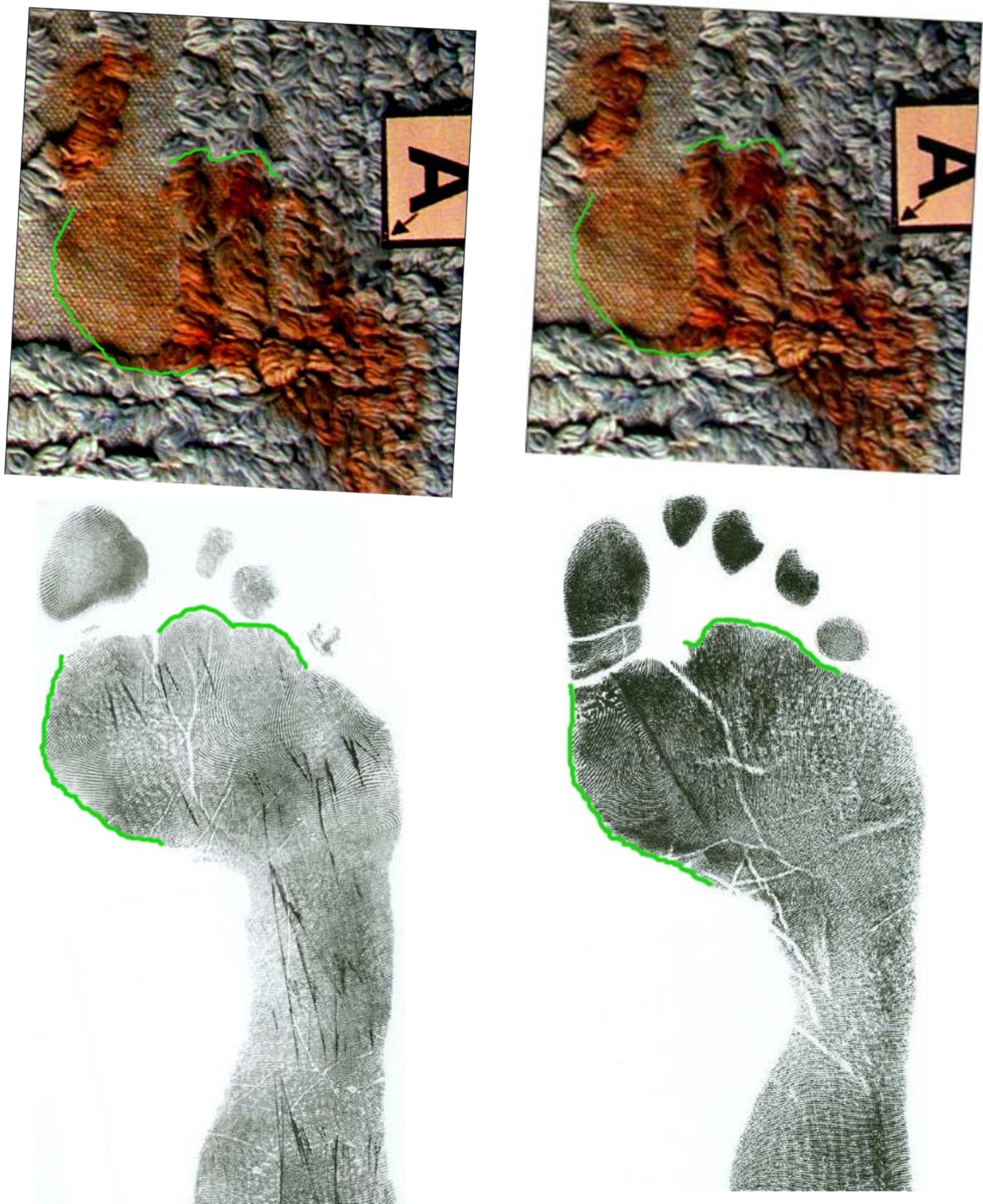
Curvatures of plantar arch are very different
The plantar arch curvature, highlighted in two different drawings (the second highlights also the upper outline “hunches”); the plantar arches in the two sample prints of Sollecito and Guede are shown below. The curvatures of plantar arch are very different.
26. The outline curvature generates different angles
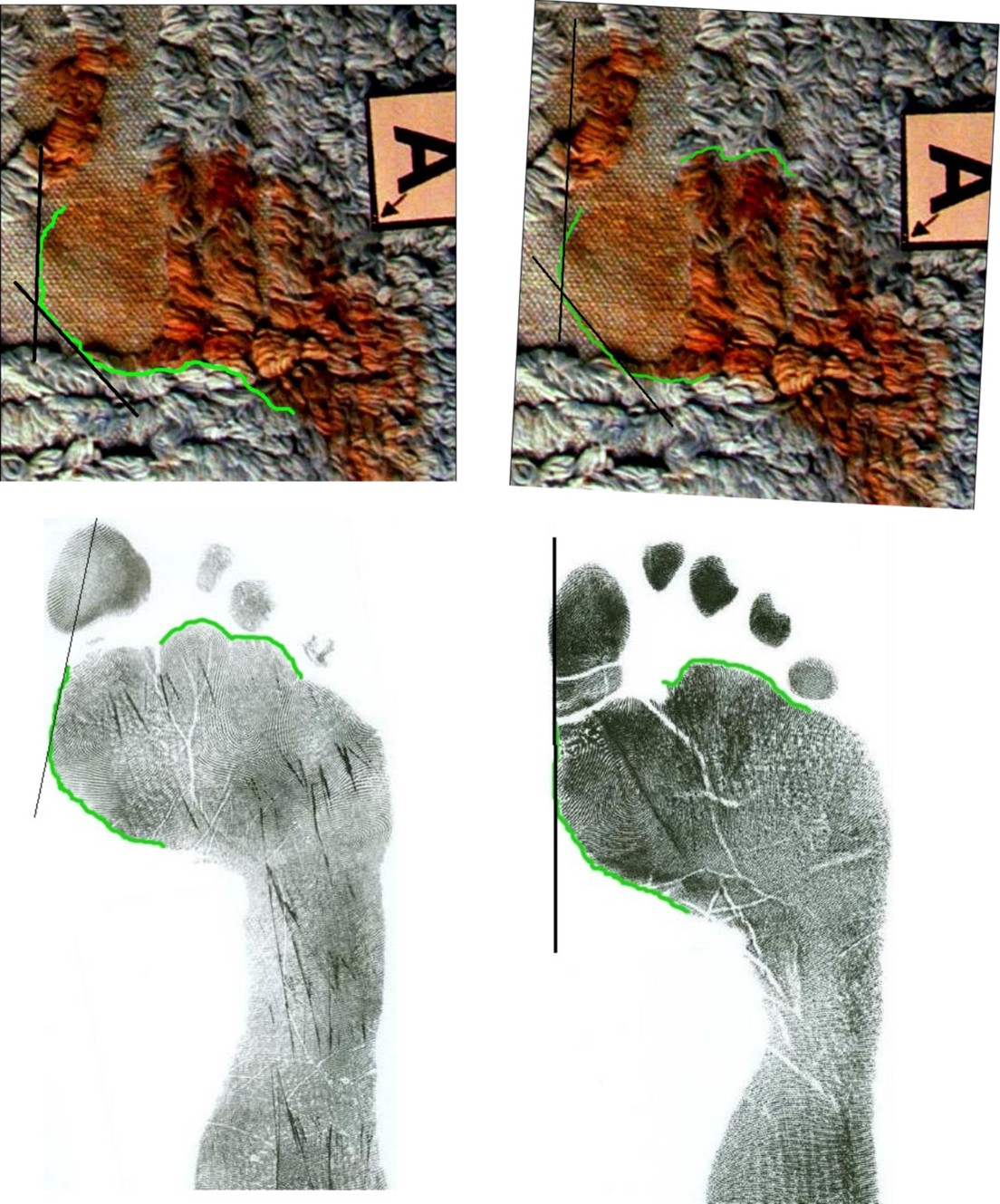
Sollecito’s and Guede’s plantar arch curvatures have very different angles. Also the left outline of metatarsus maintains a different curvature. Sollecito’s outline has an angle (see outline tangent) intersecting the toe (the metatarsus has a “bunion”); in Guede’s print there is basically no intersection, the outline and the toe form almost a straight line.
27 . Plantar arch curvature angle differs between Sollecito and Guede
If you consider the vertical axis of the sample footprint, and its orthogonal line, you may notice how the plantar arch curvatures of the two prints accomplish different angles: the two angles are VERY different, not just three or four degrees.
The (too) narrow angle of Sollecito’s plantar arch probably has a relation with the protruding outline and angle seen in pic 26., and seems related to a hallux valgus (which Guede does not have).
28 . The “cleft” on the left side of the stain
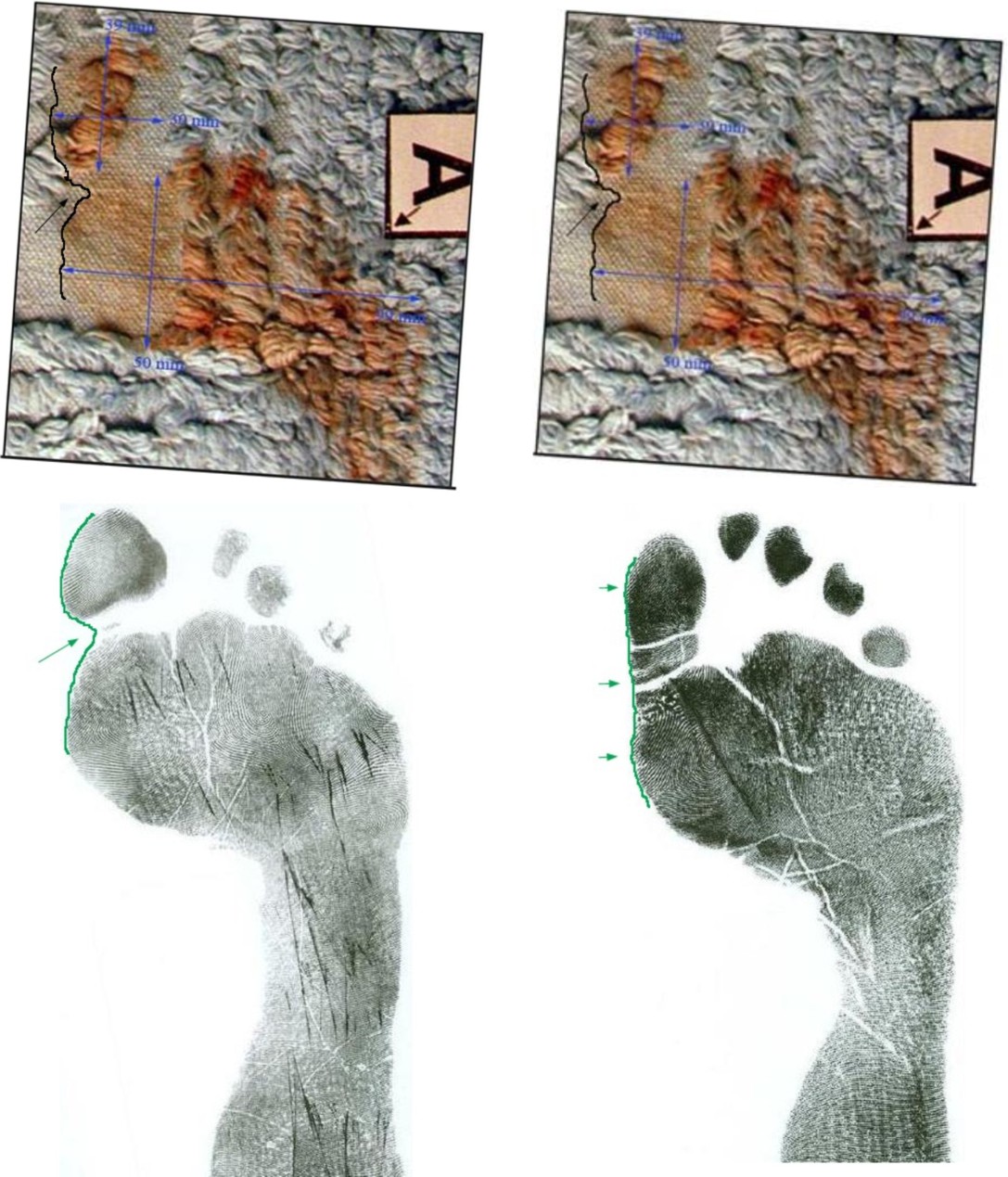
The “cleft” on the left side
This has a correspondence with one sample print, not so with the other.
29 . Table of metric comparison (by SomeAlibi)
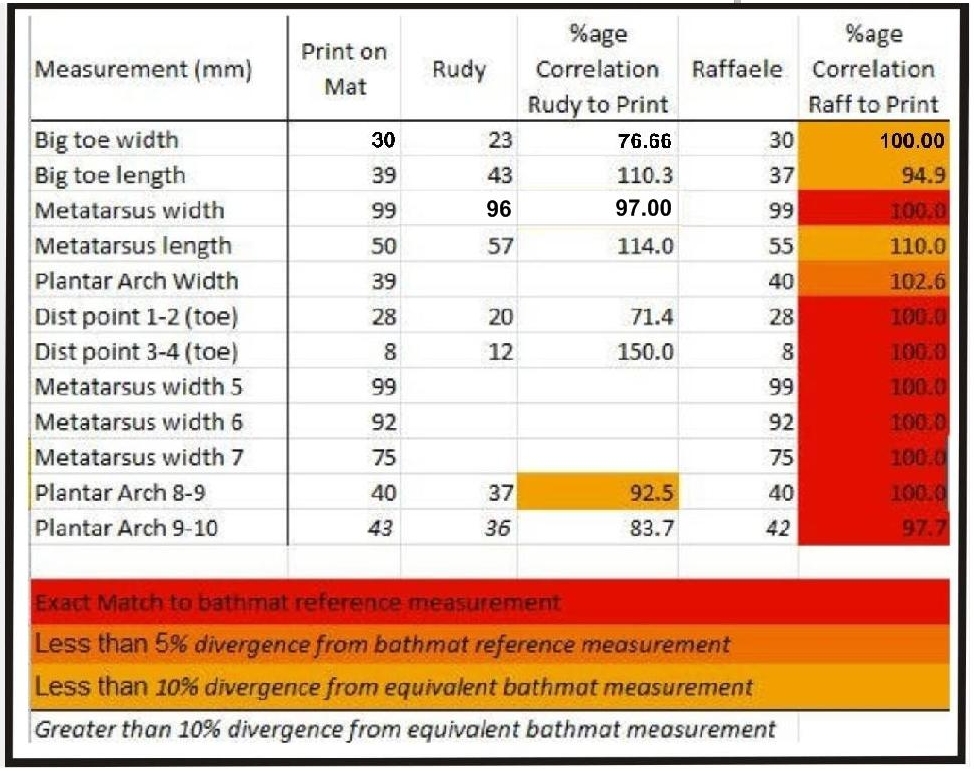
SomeAlibi’s post of a year ago
Comparison of measurements and analysis of correspondence degree of bathmat print, with both Guede’s and Sollecito’s sample prints.
Tuesday, October 22, 2013
The Meredith Case Wiki: A Highly Objective Summation Of The Case From Original Docs And Transcripts
Posted by James Raper
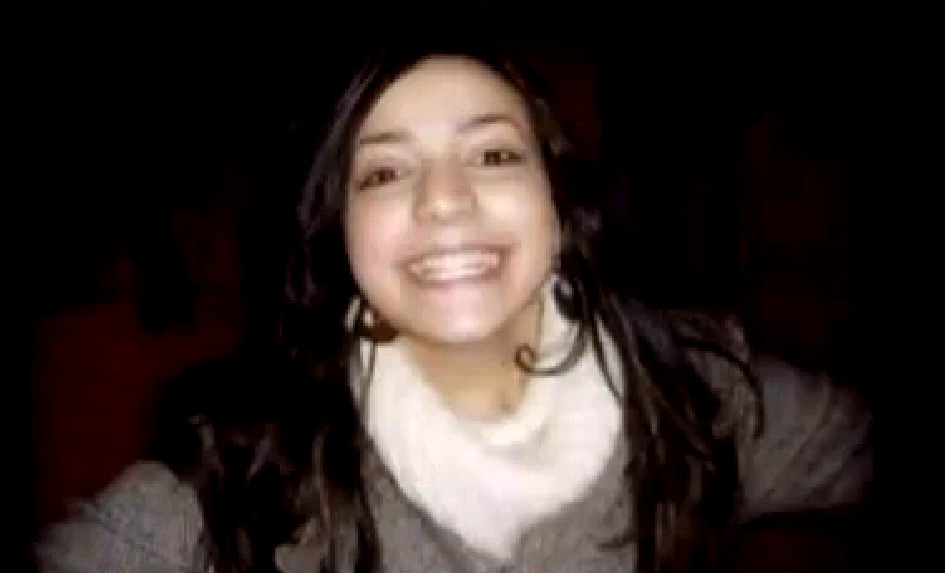
Some of our readers may not have noticed the new link to The Meredith Case Wiki to be found in the left hand column of this front page. I had not noticed it myself until recently.
This is an important link to a new website that is now a vital additional resource for those interested in understanding this case.
The website - The Murder of Meredith Kercher - is run by Edward McCall, with the assistance of other contributors, and TJMK is pleased to acknowledge and promote its distinctive and concise approach to presenting the facts of the case.
The site is modelled on the format of a page from the Wikipedia free encyclopedia. As with a Wiki page it is easily navigable. The data presented under the various headings is the consequence of much research but it still remains a work in progress. Wherever possible the material used is referenced in footnotes.
It starts on the Main page with a Mission Statement and an Introduction to the case. It then considers the evidence and has a good section entitled Myths Debunked.
The reader can easily access significant court documents: the Massei Report, the Hellmann Report, the Galati Appeal and the Supreme Court of Cassation Motivations Report. There is an accessibly summary of the Matteini and Micheli Reports.
In particular, for the researcher, there is a most welcome section entitled Court Transcripts. Here can be found transcripts of witness testimony from the Massei and Hellmann trials, experts reports, and the various writings and testimony of Amanda Knox, Raffaele Sollecito and Rudy Guede. At least that is to be the hope ultimately as there exist a good number of gaps at present.
Already some of the witness statements have been translated from Italian to English but there are a number of transcripts still to be translated. If there are any translators who would wish to help, please contact us and we shall be pleased to put your name forward.
McCall wishes to acknowledge the massive contribution made by True Justice for Meredith Kercher. TJMK has perforce grown organically and exponentially over the years and has accumulated a breadth and wealth of data, in-depth analysis and informed comment on the case which is unsurpassed on the internet, or indeed anywhere.
It will continue to do so and report developments until the conclusion of all aspects of the case.
Wednesday, July 24, 2013
How The Clean-Up And The Locked Door Contribute To The Very Strong Case For Guilt
Posted by James Raper
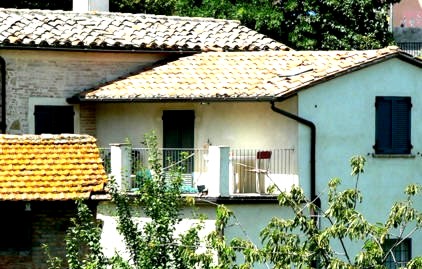
On the 30th September the appeals of Amanda Knox and Raffele Sollecito against the convictions they received at the first instance trial will resume, this time in Florence.
This follows the annulment by the Supreme Court of the acquittal verdicts rendered by the Appeal Court presided over by Judge Pratillo Hellmann. There is one conviction not under appeal. This is Knox’s conviction for calunnia, which is now definite.
They are therefore both currently convicted of murder and sexual assault, and a number of lesser charges, amongst which there is the simulation of a burglary “to ensure impunity for themselves from the felonies of murder and sexual assault, attempting to attribute the responsibility for them to persons unknown who penetrated the apartment to this end”.
There is one activity, for which there is evidence, with which they were not charged (perhaps either because it was redundant or not a criminal offence) though this was likewise to ensure impunity for themselves.
This is the partial clean up at the cottage and it is this with which I intend to deal. I want to highlight salient observations which have been under discussion here and elsewhere and some of which may be well known to readers, but perhaps some not, or have been forgotten about. Once again, in many cases, I am merely a conduit for the observations of others, not least the first instance trial judge Giancarlo Massei.
So let”˜s consider the observations and in doing so we can also throw some more light on the lone wolf theory.
1. Take a look at the bloody footprint
This is, of course, the bloody footprint on the bathmat in the small bathroom right next to Meredith’s room.
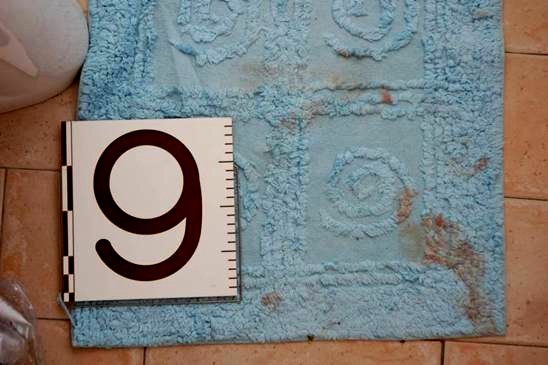
The heel of the right foot, if it had blood on it, is missing from where it should be on the tiled floor. It is difficult to imagine, given that the imprint of the foot on the mat is contiguous with the edge of the mat, that there was not at least some blood on the remainder of the foot such that there must have been at least some blood deposited on the floor.
Just as difficult to imagine that casual shuffling about on the bathmat would have removed the blood so as to render it “invisible” to the use of luminol.
Of equal relevance is that there were no connecting bloody footprints. Why not?
The defences have an improbable theory - that Guede, despite his homicidal rage, was smart enough to hop about on his left foot with a clean shoe on, and the other bare but covered in blood, and that having by this means entered the bathroom and washed his bloody right foot, disastrously leaving his (supposed) imprint there in the process, he then returned to Meredith’s bedroom inadvertently standing in blood with his left shoe and leaving with a trail of bloody left shoe prints - in which case the exercise of washing his foot was entirely in vain, on two counts, after all that careful hopping around.
Neither is it entirely clear why his right shoe came off in the first place.
It is far more probable that the inevitable bloody prints were deliberately and carefully removed. The reason for doing this was not just to conceal who would have made them (the print on the bathmat was, after all, left in situ) but, from a visual perspective, to conceal any blood that might be noticeable and alarming to anyone approaching Meredith’s room. Guede’s bloody shoeprints in the corridor were visible but only on close inspection.
2. Take a look at the bathroom door
Specifically the internal (hinge) side of the bathroom door. Take a look at this photograph.
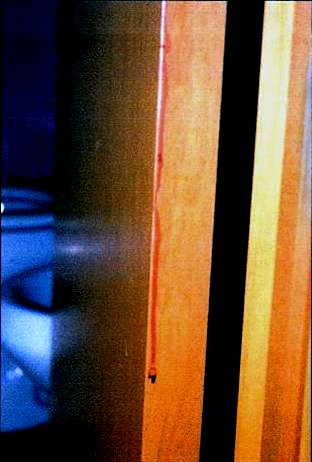
We see a long streak of dried blood. Clearly the blood has flowed some distance under the influence of gravity and we can see that it looks slightly diluted, with red corpuscles gathering towards the tip of the streak. A drip of that size does not appear from nowhere.
Indeed it is difficult to imagine how the blood got there unless it was part of a larger area of blood which most likely was on the face of the door and which was swiped to the right and over the edge of the face of the door. The cloth or towel used to do this was wet accounting for the slight dilution and length of the streak.
3. Take a look at Meredith’s door
It is interesting, is it not, that there is blood on the inside but not on the outside? The outside:
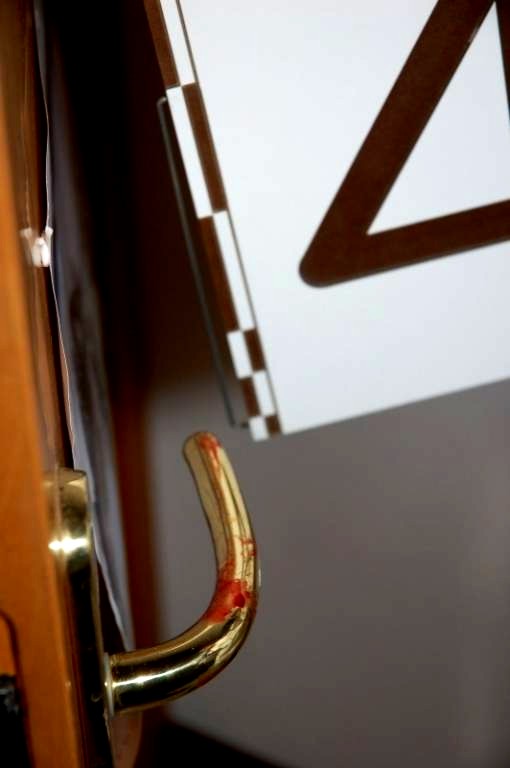
It is difficult to see how and why Guede touched the inside handle with a bloody hand (was it shut and if so, why?) and then closed the door to lock it without leaving a trace on the outside face of the door. Possibly he might have changed hands. The answer might also be that he visited the bathroom to wash his hand as well as his foot, save that none of his DNA was recovered from the spots and streaks of diluted blood in the washbasin, whereas Knox’s DNA was. All the more surprising given that Guede shed his DNA in Meredith’s room.
We see some blood on the edge of the door which again might be the remnant of a trace on the outside face.
4. Take a look at Amanda Knox’s lamp.
This was found inside Meredith’s room behind the door. Meredith also had a similar lamp which was resting on it’s base on the floor by her bedside table.
The presence and location of Knox’s lamp is obviously suspicious. Had Meredith borrowed Amanda’s lamp because her own was not working, then it would not have been in the position it was found but on or more likely knocked over and lying beside the bedside table since the violence appears to have been concentrated in that area of the room.
Had Meredith’s lamp been on the bedside table then likewise it too would most likely have been knocked over in her life and death struggle with her sole assailant (there are blood streaks on the wall just above) and it would not have ended up sitting upright on it’s base.
Both lamps were probably used to check the floor of Meredith’s room after the event and Knox’s lamp was probably sitting upright until it was knocked over by the door being forced open.
This is Meredith’s lamp by the bedside table.
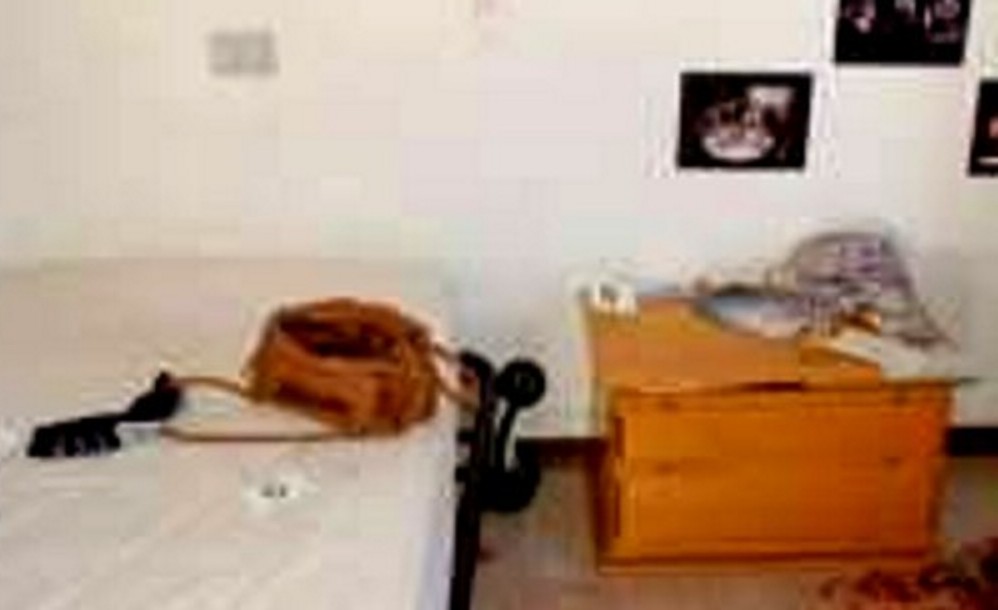
And this is Knox’s lamp by the foot of the bed.
5. Take a look at what luminol revealed
We can state with confidence that luminol (extremely sensitive to and typically used to identify blood that has been wiped or washed away) discovered :-
(a) three bare footprint attributable to Knox, one in her bedroom and two in the corridor, and
(b) two instances of the mixed DNA of Meredith and Knox, one in Filomena’s bedroom and one in the corridor.
(c) a footprint attributed to Sollecito in the corridor.
I have covered a number of elements strongly suggesting that there was at least a partial clean up, not of “invisible DNA” as the Groupies like to mock, but of what would have probably in some cases have been noticeable deposits of blood that would have attracted the eye of anyone entering the cottage and which would certainly have alarmed the observer as being difficult to explain.
Spots of and footprints in blood, not just in the bathroom but outside it, a locked bedroom door with blood on it, and a bathroom door with blood on it’s face.
We can include Knox as one such observer given her e-mail account of having allegedly stopped by the cottage to have a shower and collect some clothing before the discovery of the body. Such physical evidence - had it not been removed - would not have sat easy with that account, however dizzy and naïve Knox presents herself. One can envisage Knox thinking “sorted” - that her story would now work perfectly.
Even so, there were elements that were overlooked, such as Knox’s blood on the washbasin faucet and blood generally in the small bathroom, but a door can be closed and at least these were elements amenable to some form of explanation from her perspective, whether or not convincing, as occurred in the e-mail.
Incidentally in addition to the mixed traces in the small bathroom, Meredith’s blood was found on the light switch and a cotton bud box. I have a hard time imagining what Guede would have wanted with the cotton bud box, less so Amanda given her blood on the faucet, ear piercings and a scratch on her throat. Knox, when asked during her trial, could not recall having switched on the light during her alleged visit to the cottage.
6. Take a look at the items on Knox’s bed
Massei concluded that it was likely that it was Knox who carried out the clean up, which if correct might explain why it was not central to her thinking to dispose of the bathmat with Sollecito’s bloody footprint on it!
Knox was seen by Quintavalle at his store at 7.45 am on the 2nd November, thereby destroying her alibi. He described her as pale faced, exhausted looking, with pale blue eyes. He also added, and he would not have known this from photographs in the newspapers, that she was wearing blue jeans, a grey coat and a scarf, with a hat or cap of some sort.
We can see from the crime scene picture of Knox’s bedroom below, that such items (minus hat or cap) appear to be lying on her bed.
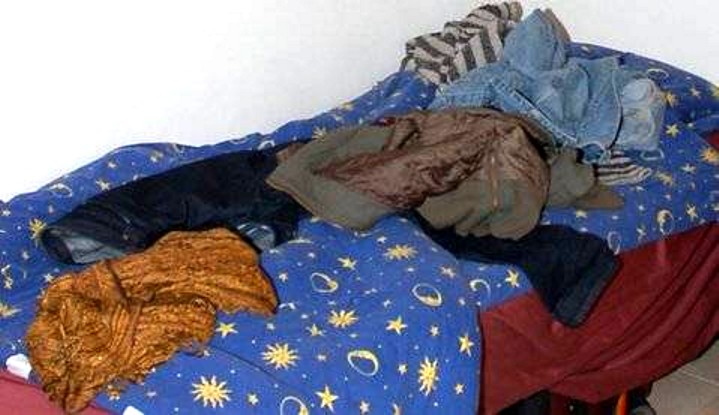
Sollecito did not accompany Knox to the store but this would be because he was known to Quintavalle whereas he was unfamiliar with her. He may however have accompanied Knox to the cottage and/or have acted as look out for her when she was there.
7. Some conclusions
I have included “The locked room” in the title because of a poster’s observation regarding Guede’s bloody left shoeprints exiting Meredith’s room. There is the simple observation that these footprints are going one way only and not towards the small bathroom. But they do not even turn to face Meredith’s door, and again hard to imagine that this could be so if it was Guede who locked her door!
We can rule out Guede as having been involved in any aspect of the clean up precisely because of that trail of footprints and other evidence of his presence left behind.
Now that the travesty of the Hellmann acquittals has been truly exposed Knox and Sollecito face an impossible uphill task.
The clean up and the locked door are just two of many elements in this case which combine together and corroborate each other in a manner that enables us to see the truth beyond a reasonable doubt.
Wednesday, May 01, 2013
A Welcome To New Arrivals #1: An Experienced Trial Lawyer Recommends How To Zero In On the Truth DRAFT
Posted by Some Alibi
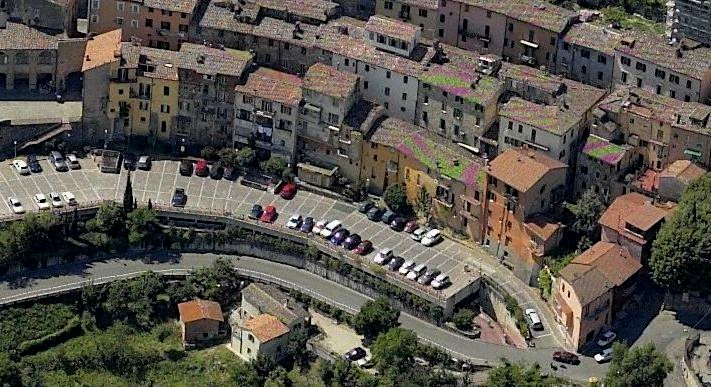
[Merediths window is seen on the top floor of the house in the lower foreground]
Welcome To Common Sense
This briefing was first posted with slightly different opening paras at the start of the annulled Hellmann appeal. New arrivals often tell us this helped them the most.
If you’ve come to this website because of the Amanda Knox book and interview, then welcome. Like all of us who come to this case, you have one key question: did they do it? The Knox book and interview seriously cherrypick the case, and perhaps haven’t helped you at all.
On the Internet, you will find people who are passionate in their defence of Amanda Knox and Raffaele Sollecito; and you will find people who are passionate in their support of an exceptionally talented girl who died, of a fine justice system previously untainted by PR, and of the prosecution’s very strong case.
Please click here for more
Monday, April 08, 2013
Experienced Trial Lawyer: There’s Far More Evidence Than UK/US Courts Need For Guilt
Posted by SomeAlibi
The false claim “there is no evidence”
Some amateur supporters of Knox and Sollecito have committed thousands of hours online to try and blur and obfuscate the facts of the case in front of the general public.
Their goal is simple: to create an overwhelming meme that there is “no evidence” against the accused, and thereby try to create a groundswell of support. Curt Knox and Edda Mellas and Ted Simon have all made this “no evidence” claim many times.
At least some some of the media have eagerly swallowed it.
The amateur PR flunkies make up myriad alternate versions of what created single points of evidence, often xenophobic scare stories designed to trigger emotional reactions, which they hope will be repeated often enough to become accepted as “the truth”.
And where things get really tricky, another time honored tactic is to go on at great length about irrelevant details, essentially to filibuster, in the hope that general observers will lose patience with trying to work it all out.
But time and again we have shown there is actually a great deal of evidence.
Evidence is the raw stuff of criminal cases. Let me speak here as a lawyer. Do you know how many evidence points are required to prove Guilt? One evidence point if it is definitive.
A definitive evidence point
If you’re new to this case or undecided, what is an easy example of ONE definitive evidence item that might stand alone? Might quickly, simply, and overwhelmingly convince you to invest more time into understanding the real evidence, not that distorted by the PR campaign?
In fact we have quite a choice. See the footprint which was second on that list.
Now see the table above. I recommend the use of this table of measurement to avoid the lengthy back and forward of narrative argument which so lends itself to obscuring the truth. I would like to present you with this single table of measurements to give you pause to question whether this line that there is “no evidence” is really true or whether it might be a crafted deception.
I present here a summarized view of critical evidence which suggests with devastating clarity that Raffaele Sollecito was present the night of the murder of Meredith Kercher. No lengthy text, no alternate versions, just measurements.
This FIRMLY places Sollecito in the very room where Meredith was attacked and killed.
In the small bathroom right next to Meredith’s bedroom was a bathmat. On it was found a bloody naked right footprint of someone walking straight towards the shower in the bathroom. The blood is that of Meredith.
The footprint is not Amanda Knox’s - it is too big - but we can compare it to the prints taken of Rudy Guede and Raffaele Sollecito.
In Judge Massei’s report the multiple measurements were detailed in the narrative over many sentences and, in that form, their immediate cumulative impact is less obvious. It is only by tabulating them, that we are forcefully hit by not one but two clear impressions:
The measurements are extremely highly correlated to the right foot of Raffaele Sollecito in twelve separate individual measurements. In themselves they would be enough for a verdict of guilt in all but a few court cases.
But they also show a manifest LACK of correlation to the right foot of Rudy Guede, the only other male in that cottage on the night. Have a look for yourself.
If you were the prosecution, or indeed the jury, and you saw these measurements of Raffaele’s foot versus the print, what would you think? Answer the question for yourself based on the evidence admitted to court.
Then, if you compare further, exactly how plausible do you find it that the measurements of the bloody imprint are Rudy Guede’s instead?
Not only are some of the individual measurements of Rudy’s imprint as much as 30% too small, but the relative proportions of length and breadth measurements are entirely wrong as well, both undershooting and overshooting by a large margin (70% to 150%).
Conclusions that must follow
Presented with those numbers, would you consider those measurements of Rudy Guede’s right foot to show any credible correlation to those of the footprint on the mat?
Supporters of the two have tried frantically to create smoke screen around this - the wrong technique was used they say (ruled not so by the court) / they are the wrong measurements (all 32 of them? that Raffaele’s are matching exactly or within a millimetre but Rudy’s are out by as much as -30% to +50%...?).
The severity of the impact on the defence is such that there was even a distorted photoshopped version circulated by online supporters of Raffaele and Amanda until they were caught out early on in coverage. But it is hopeless, because these are pure measurement taken against a scale that was presented in court and the data sits before you.
Have a look at the measurements and understand this was evidence presented in court. Whose foot do you think was in that bathroom that night? Rudy Guede? Or was it Raffaele Sollecito on twelve counts of measurement?
And if you find for the latter, you must consider very seriously what that tells you both about the idea there is “no evidence” in this case and who was in the cottage that night…

